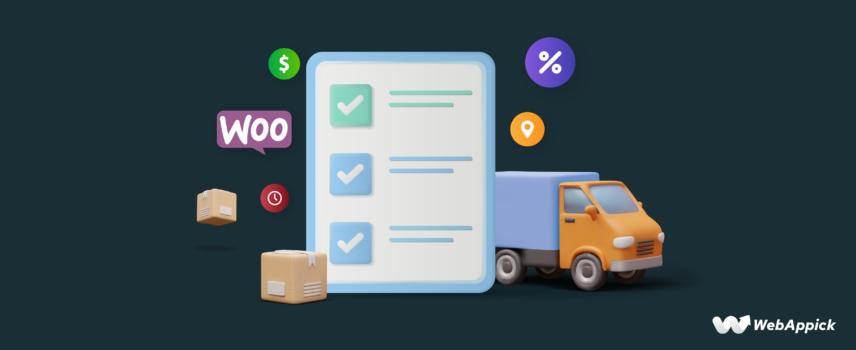
How to Set Up WooCommerce Table Rate Shipping
Do you know the number one reason why customers abandon a cart (leave without buying after adding products to the cart)?
Unexpected shipping cost. A staggering 70% of customers ditch their carts online, and high or unclear shipping fees are the leading reason behind it.
Therefore, you must have flexible shipping options to cater to diverse customer needs. WooCommerce table rate shipping empowers you to achieve just that.
It allows you to create customized shipping rates based on various factors, giving you granular control over your shipping strategy.
Imagine offering competitive rates for local customers, rewarding high-value orders with free shipping, or setting location-based pricing – all with table rate shipping methods for WooCommerce!
In this article, we’ll delve into what it is and how to set up table rate shipping in WooCommerce.
What is WooCommerce Table Rate Shipping?
Is it a specific tool or setting in WooCommerce?
Not really. Table rate shipping is a general term used to describe a method of calculating shipping costs based on predefined tables or matrices of rates.
In simple words, you set some condition rules to calculate shipping charges based on various factors such as destination, weight, quantity, dimensions, or total order value. Retailers like you create conditions (aka tables or matrixes) with specific shipping rates corresponding to different combinations of these factors.
When a customer makes a purchase, the system consults this table (check conditions/formulas) to determine the appropriate shipping charge for their order. This approach allows for flexibility in pricing based on different shipping criteria.
There’s no dedicated tool in default WooCommerce Shipping for table rate shipping configuration. However, you can work your way around to some extent using the Flat Rate shipping method in WooCommerce to function similarly to table rate shipping by setting up different rates based on conditions.
In addition, you can apply and combine shipping classes with flat rates to generate table rate shipping for WooCommerce.
So, while “table rate shipping” is not a specific tool within WooCommerce, you can achieve a few similar functionalities using the built-in Flat Rate shipping method with appropriate configuration.
And there’s always the option to integrate third-party plugins. There are a large number of WooCommerce table rate shipping plugins available to help you set your desired shipping rates.
In the following sections, we will explore built-in methods and the best table rate shipping plugin for WooCommerce.
Different Table Rate Shipping Conditions
WooCommerce table rate shipping conditions can vary depending on your needs and the complexity of your shipping policies.
Here are some possible conditions you can use to calculate shipping rates in a table rate shipping setup:
- Destination Zone: Shipping rates can vary based on the shipment’s destination, such as different countries, states, or zip codes. If you sell globally, you need to set different rates for different locations based on your shipment cost.
- Order Weight: Shipping rates can be based on the total weight of the order. Shipping companies (e.g., DHL, FedEx, etc.) often charge based on the weight of the package being shipped. This is because the weight of the package is a key factor in determining the cost of shipping. Generally, the heavier the package, the more it will cost to ship.
- Order Subtotal: Rates can be determined by the total value of the order before taxes and shipping costs are applied.
- Quantity of Items: Rates can be set based on the number of items in the order.
- Shipping Class: Different rates can apply to items assigned to specific shipping classes.
- Product Dimensions: Rates can be calculated based on the dimensions of the products being shipped, such as length, width, and height.
- Shipping Method: Rates can vary depending on the chosen shipping method, such as standard shipping, expedited shipping, or overnight shipping.
- Cart Contents: Rates can be determined based on specific products or categories present in the shopping cart.
By configuring shipping rates using these conditions in a table format, you can create a flexible and customized shipping structure that meets the needs of your customers.
Examples
Here are some valid examples of WooCommerce table rate shipping:
1. Destination-based Rates:
– Shipping within the same country:
- Zone 1 (Local): $5.00
- Zone 2 (Regional): $8.00
- Zone 3 (National): $10.00
– International shipping:
- Zone 4 (North America): $15.00
- Zone 5 (Europe): $20.00
- Zone 6 (Rest of the World): $25.00
2. Weight-based Rates:
- Up to 1 kg: $5.00
- 1-5 kg: $8.00
- 5-10 kg: $10.00
- Over 10 kg: $15.00
3. Quantity-based Rates:
- 1 item: $5.00
- 2 items: $8.00
- 3-5 items: $10.00
- 6-10 items: $15.00
4. Combination of Weight and Destination:
Within Zone 1 (Local):
- Up to 1 kg: $5.00
- 1-5 kg: $8.00
Zone 2 (Regional):
- Up to 1 kg: $8.00
- 1-5 kg: $12.00
Within Zone 3 (National):
- Up to 1 kg: $10.00
- 1-5 kg: $15.00
5. Tiered Rates based on Order Value:
- Up to $50: $5.00
- $50 – $100: $8.00
- $100 – $200: $10.00
- Over $200: Free shipping
These examples illustrate how to use table rate shipping WooCommerce based on different factors such as destination, weight, quantity, or order value. You can adjust specific rates and conditions according to your needs and policies.
How to Setup WooCommerce Table Rate Shipping Using Built-in Settings
The built-in settings in WooCommerce shipping allow you to offer flexible shipping options to your customers. In addition to static rates, you can offer multiple shipping options to cater to different preferences and needs, enhancing the overall shopping experience for your customers.
When it comes to WooCommerce table rate shipping, the platform itself does not have built-in table rate shipping functionality in the traditional sense. However, there are ways to achieve a similar outcome with some workarounds.
Let’s quickly review the default settings and find ways to achieve table rate shipping conditions.
Go to WooCommerce >> Settings >> General >> General Options.
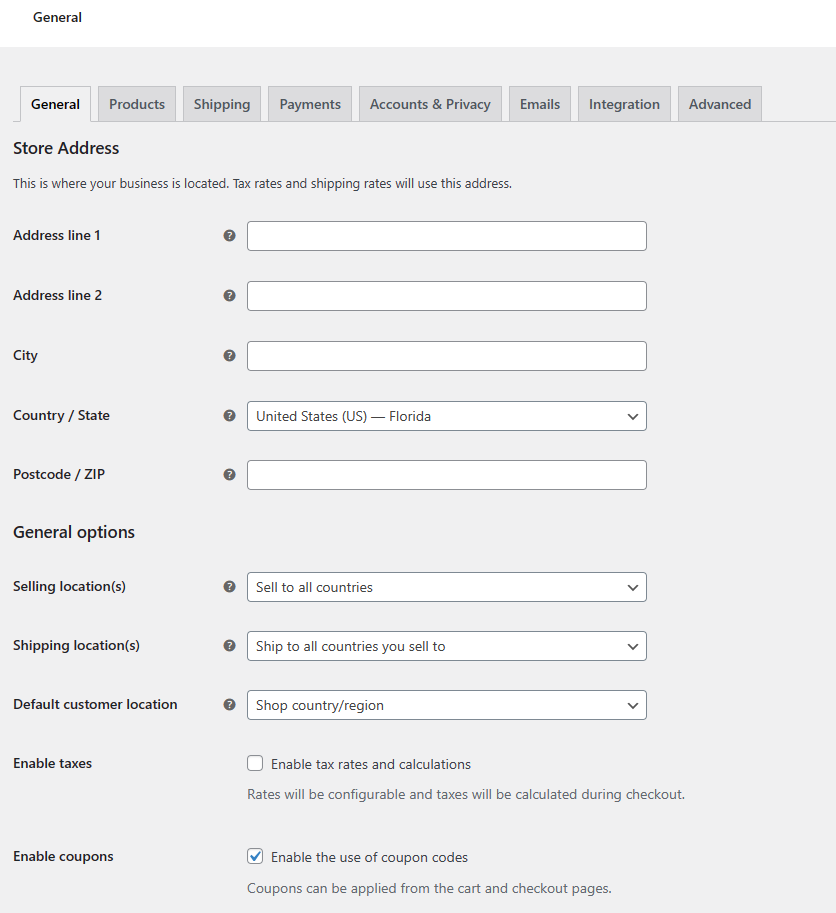
From here, you can set the location of your store, where you are willing to sell, and how the system should detect the customer’s location.
For a complete walkthrough, check out our guide on WooCommerce Shipping.
From the Shipping tab, you can create different shipping rules. Here’s what you need to know –
Shipping Zone – You can define shipping rates for specific areas. For example, you are from the USA, but you can deliver to the UK. However, shipping rates are understandably different for international shipments. Therefore, you can create a Shipping Zone for the UK and set shipping methods and rates. As a result, customers from the UK will see the appropriate shipping costs automatically.
Shipping Methods – WooCommerce supports three shipping methods under every shipping zone –
- Free Shipping
- Flat Rate
- Local Pickup
Shipping Class—This option, when combined with Flat rate cost conditions, allows you to somewhat mimic table rate shipping.
Flat Rate Cost variables
Along with static values, the Cost field in the flat rate shipping method allows you to set conditional shipping costs. Here are the available placeholders.
- [qty]: This represents the number of items in the customer’s shopping cart. For example, if they have 3 items in their cart, we’ll use this number to calculate shipping.
- [fee percent=”numeric value”]: This calculates the shipping fee based on a percentage of the total order cost. For instance, if we set [fee percent=”10″], it means the shipping fee will be 10% of the total order cost.
- min_fee=”numeric value”: This ensures that the shipping fee is never lower than a certain amount. For example, if we set min_fee=”5″, even if the calculated shipping fee is less than $5, it will be bumped up to $5.
- max_fee=”numeric value”: This sets the maximum shipping fee to prevent overcharging. For example, if we set max_fee=”20″, even if the calculated shipping fee exceeds $20, it will be capped at $20.
Read our full guide on WooCommerce shipping to find details about these variables and real-life examples of how to apply them.
Create Multiple Shipping Options WooCommerce Table Rate Using Default Settings
Now, using the existing options, we will try to replicate the examples of WooCommerce table rate shipping we mentioned earlier.
The first example was –
Destination-based Rates
– Shipping within the same country:
- Zone 1 (Local): $5.00
- Zone 2 (Regional): $8.00
- Zone 3 (National): $10.00
– International Shipping:
- Zone 4 (North America): $15.00
- Zone 5 (Europe): $20.00
- Zone 6 (Rest of the World): $25.00
Let’s set shipping according to this from WooCommerce >> Settings >> Shipping. Add a new shipping zone.
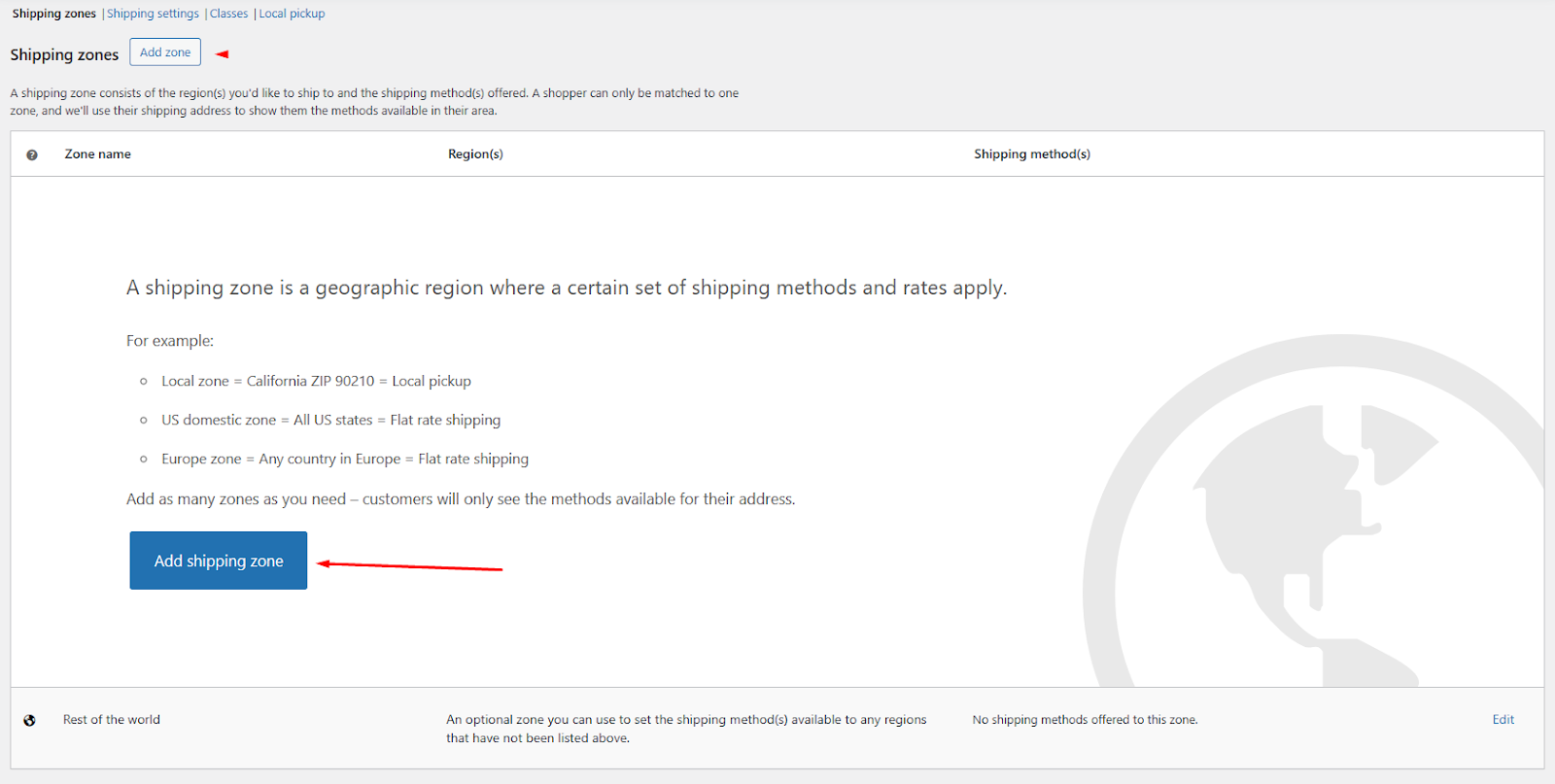
Name the zone as Local. Let’s say your store is in Florida, and you want to charge your local customers a $5 fee.
Select your location from the Zone Regions dropdown. You can also set your location by zip code as well.
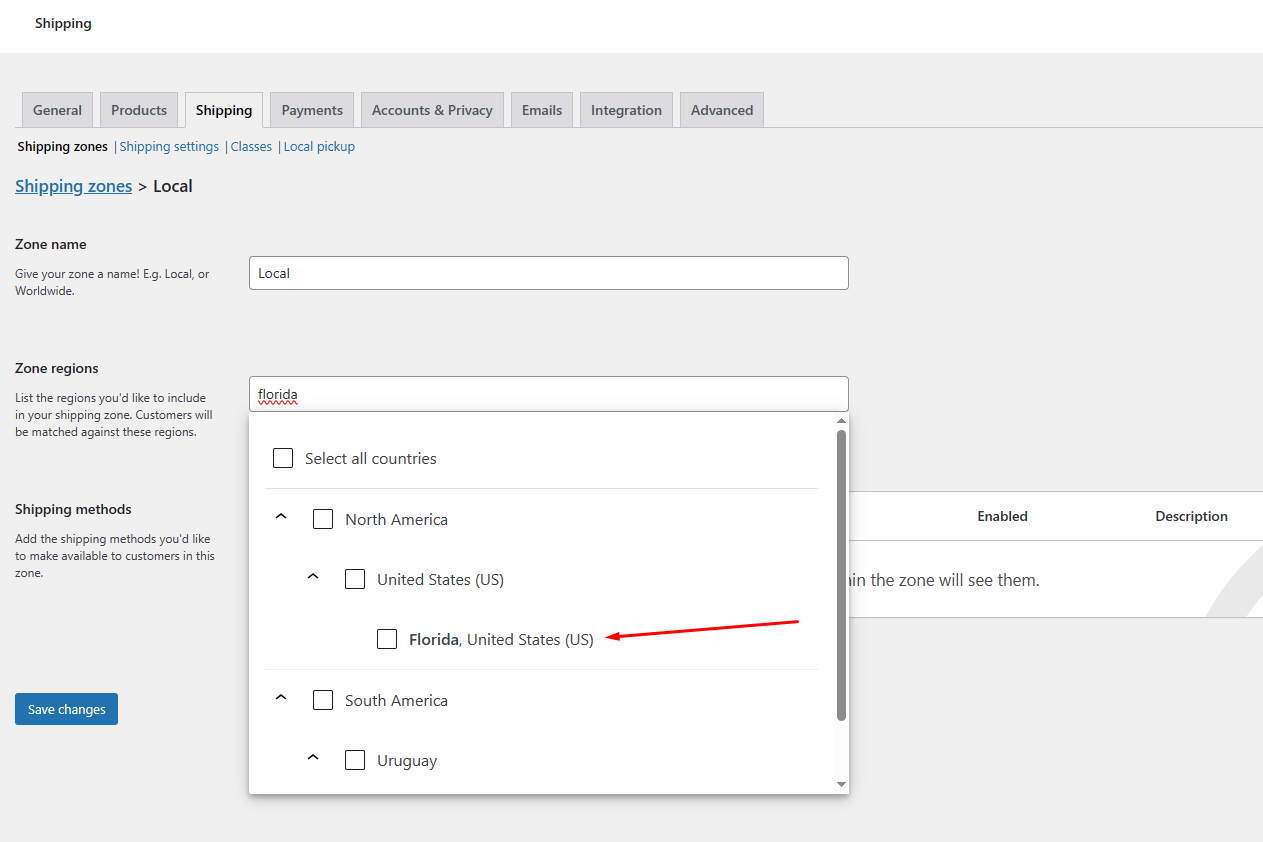
Next, click on the “Add Shipping Method” button.
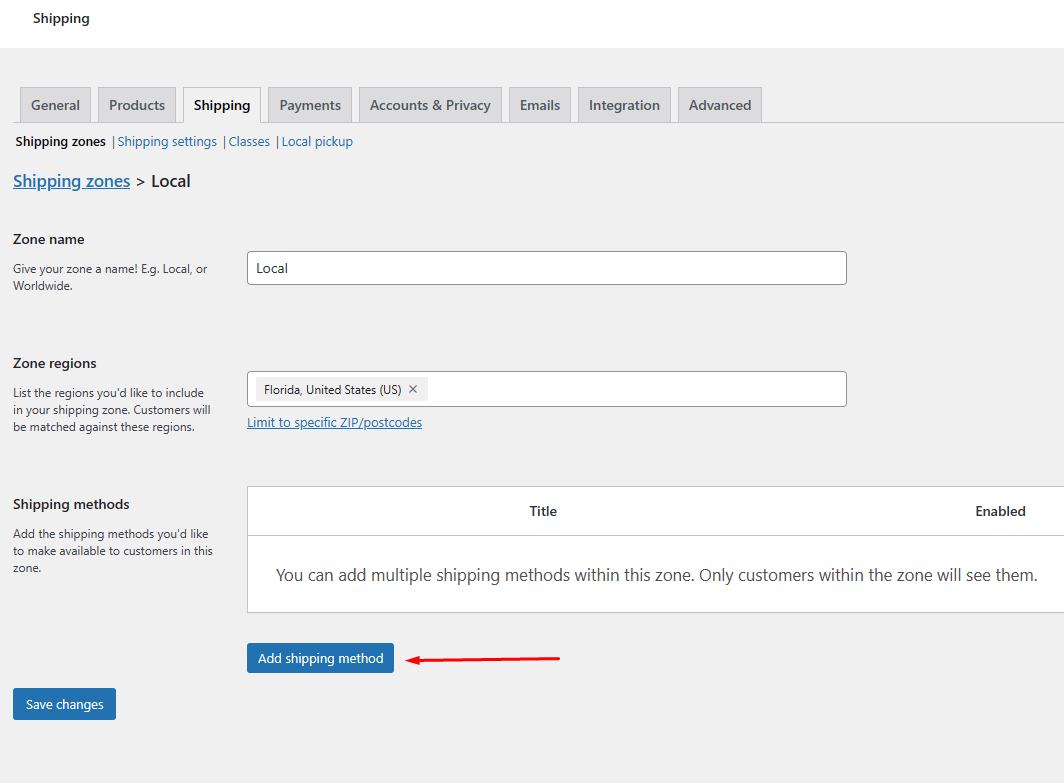
Select the Flat Rate option and continue.
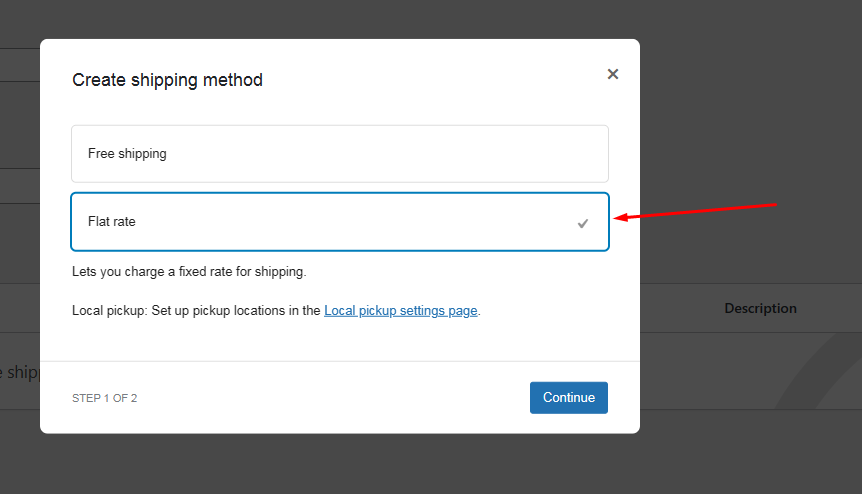
Name your shipping option. The cost field is where you input your shipping cost.
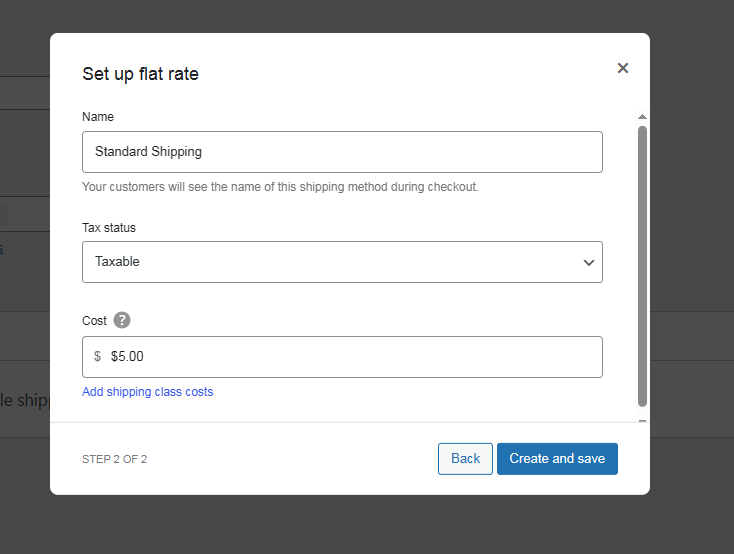
Save your shipping methods and zone when done. Similarly, create zones and set rates for Regional zones.
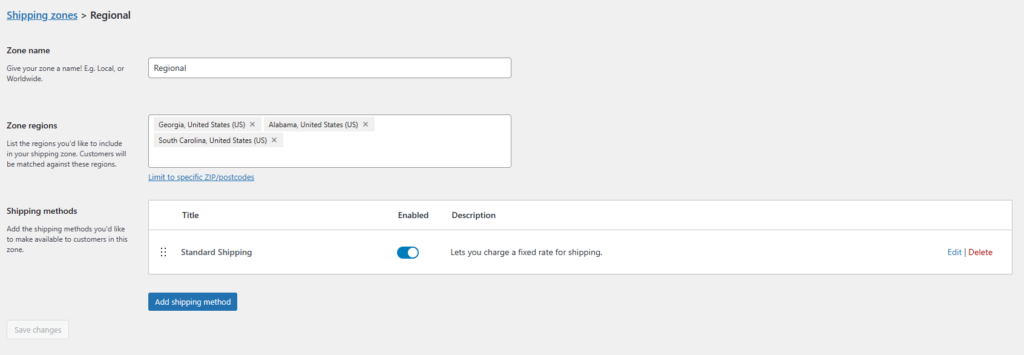
Lastly, create a zone and rate for the national customers (Entire USA).

Time to check if your customers will see the appropriate shipping rates or not. Go to your front end and add some products to the cart.
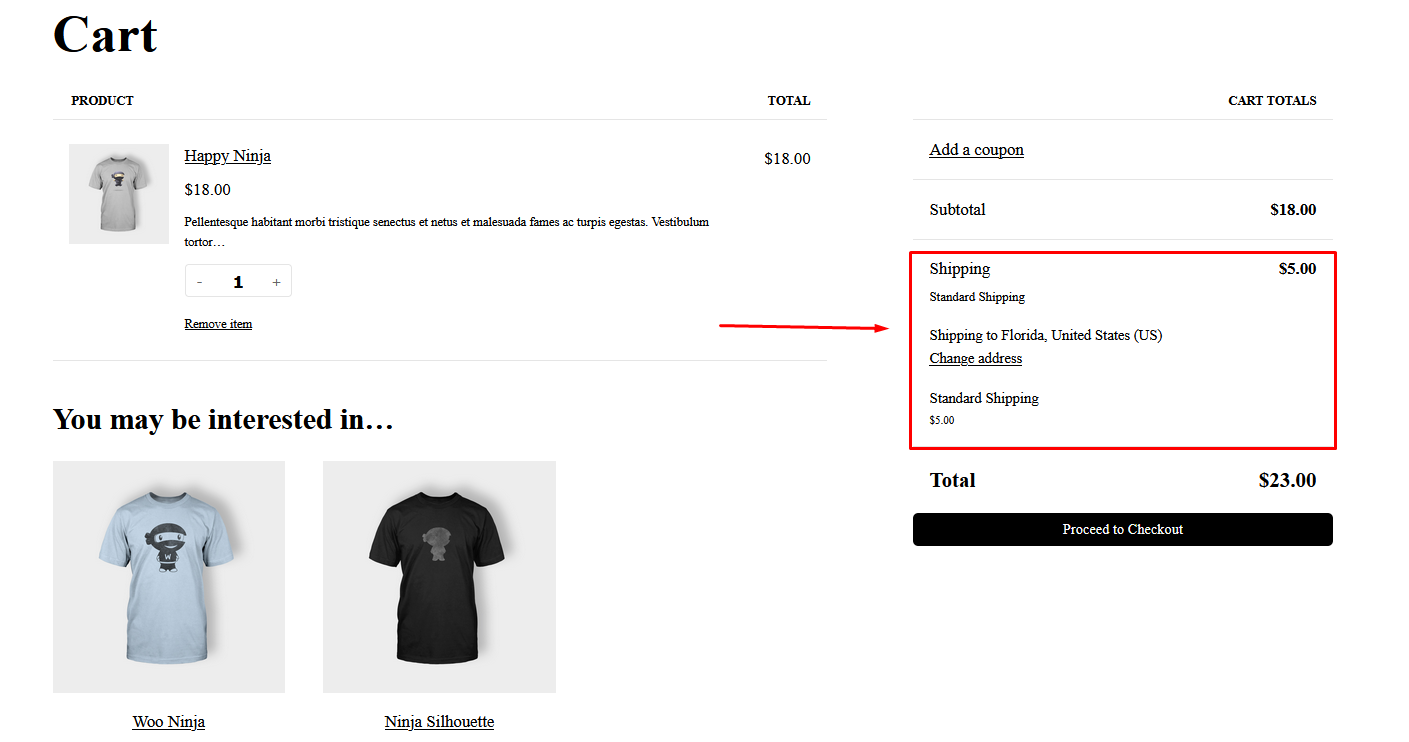
As you can see, for customers from Florida, the shipping rate is showing $5. Let’s change the address to a Regional location (e.g., Georgia).
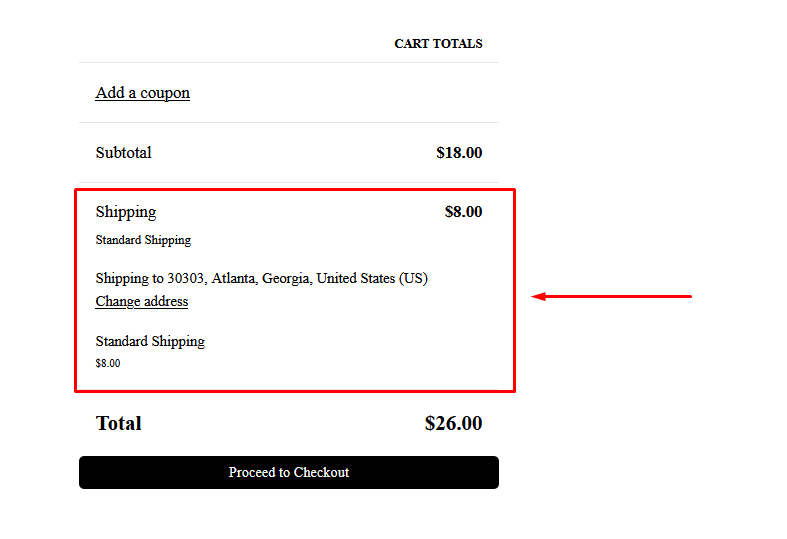
Voila! Lastly, Let’s check out the national rate. Set any state apart from local and regional.
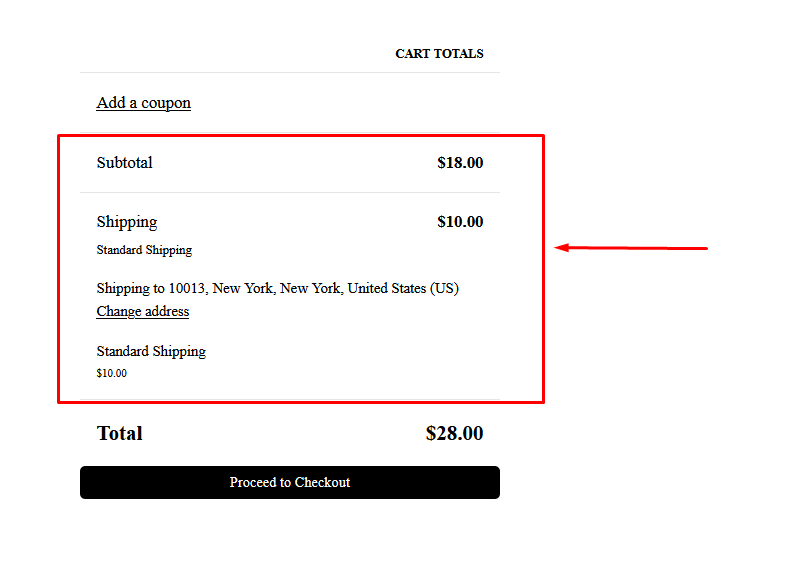
Similarly, you can create zones and rates for North America and Europe as per the example.
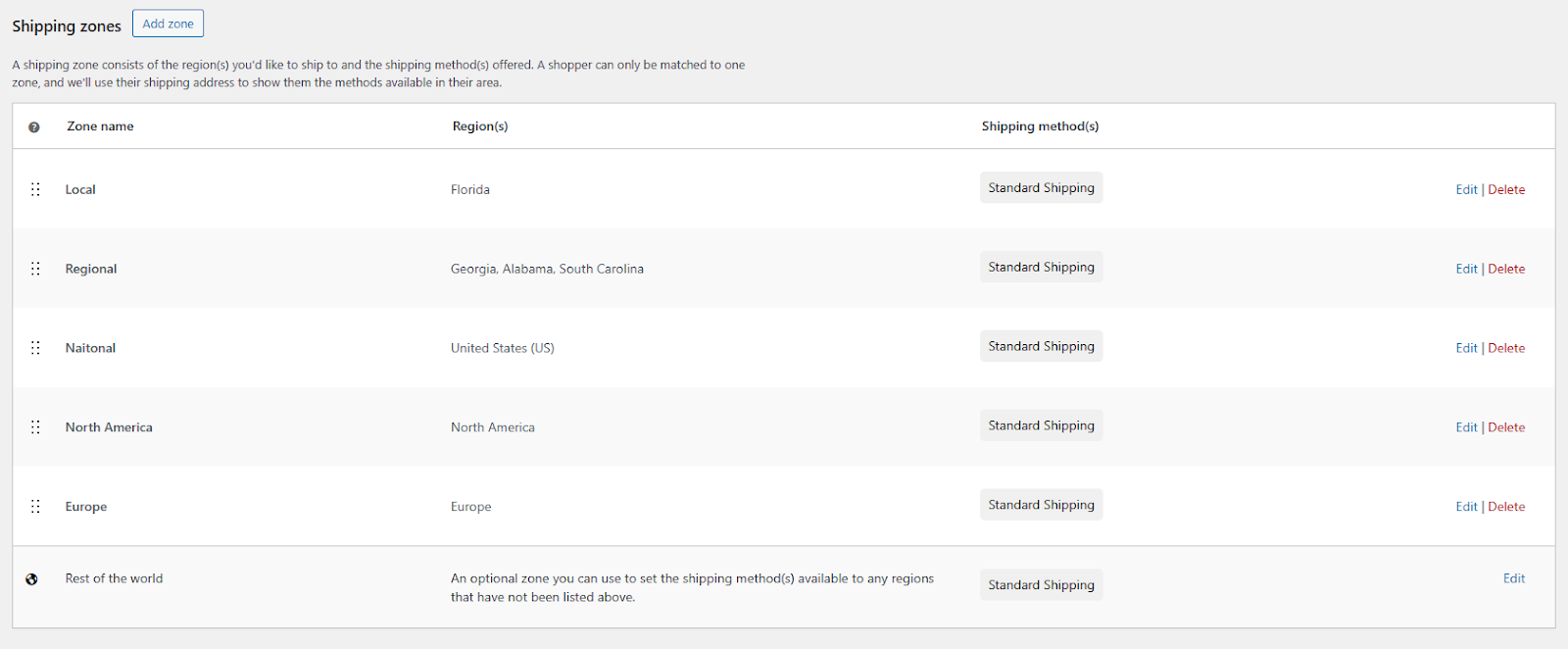
Here’s an international shipping cost example –
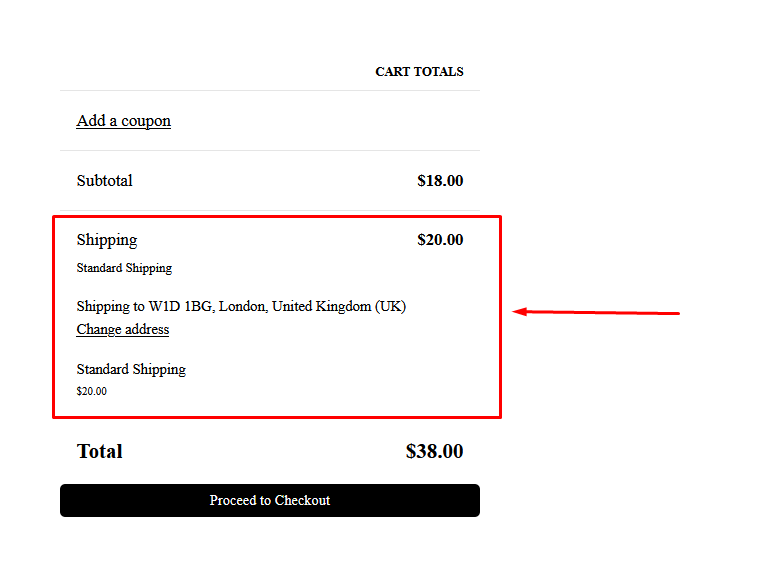
For the Rest of the world, there’s a dedicated zone you might have noticed already. You simply need to click edit and add a flat rate to that zone.
Replicating WooCommerce Table Rate Shipping Example 2
The second example was –
Weight-based Rates:
- Up to 1 kg: $5.00
- 1-5 kg: $8.00
- 5-10 kg: $10.00
- Over 10 kg: $15.00
To achieve this with default settings, you will need to apply shipping classes. Let’s directly jump to the Shipping Classes tab.
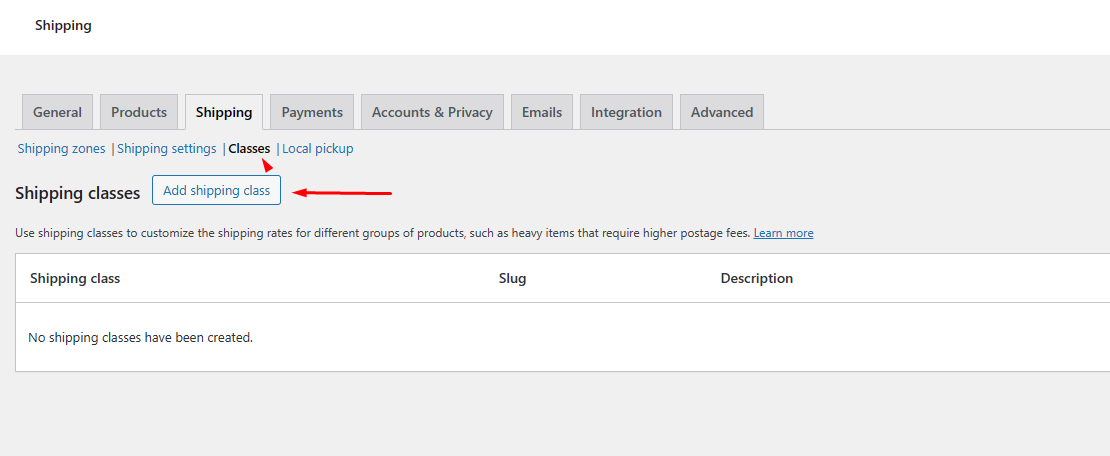
Add a shipping class, name it Up to 1 kg, and set other details.
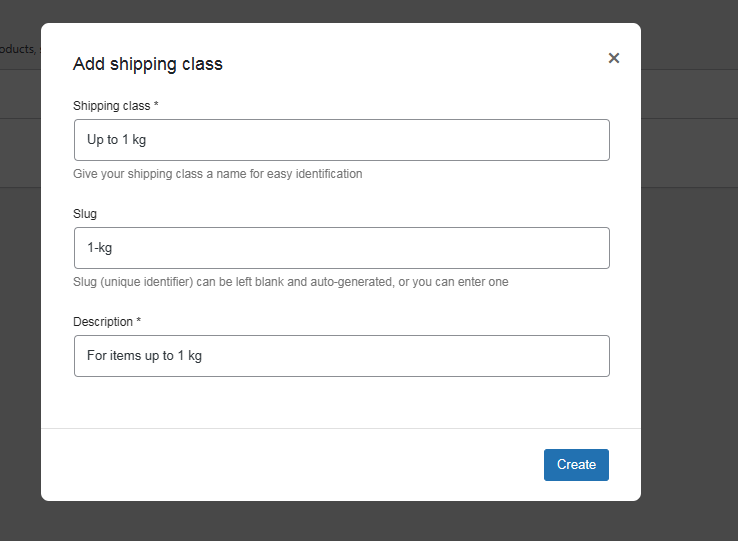
Similarly, add other classes.

Next, go to the product pages to assign these classes. For example, a product with 0.3 kg will have the class Up to 1 kg.
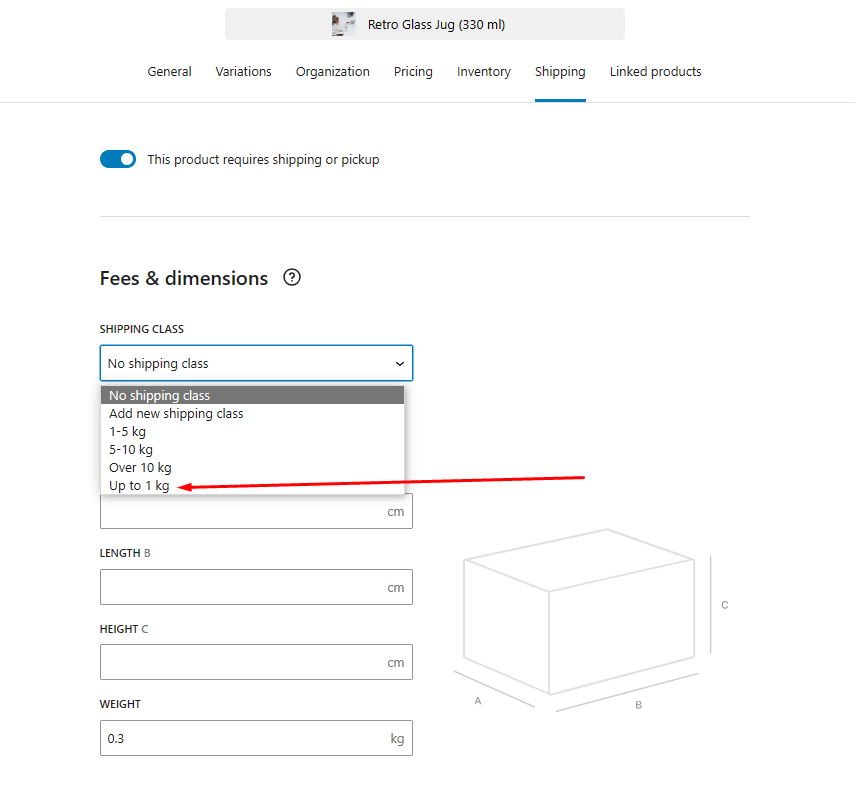
Similarly, add other classes to the appropriate products.
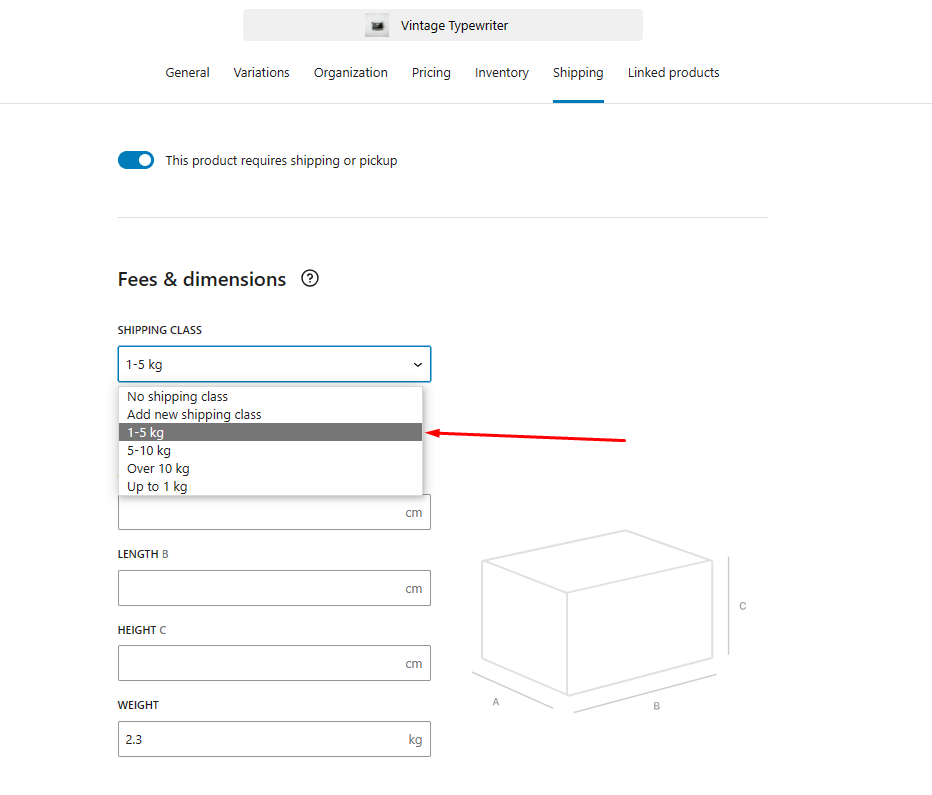
You can also bulk-assign shipping classes from the All Products page. Go to All Products and filter your products according to your requirements.
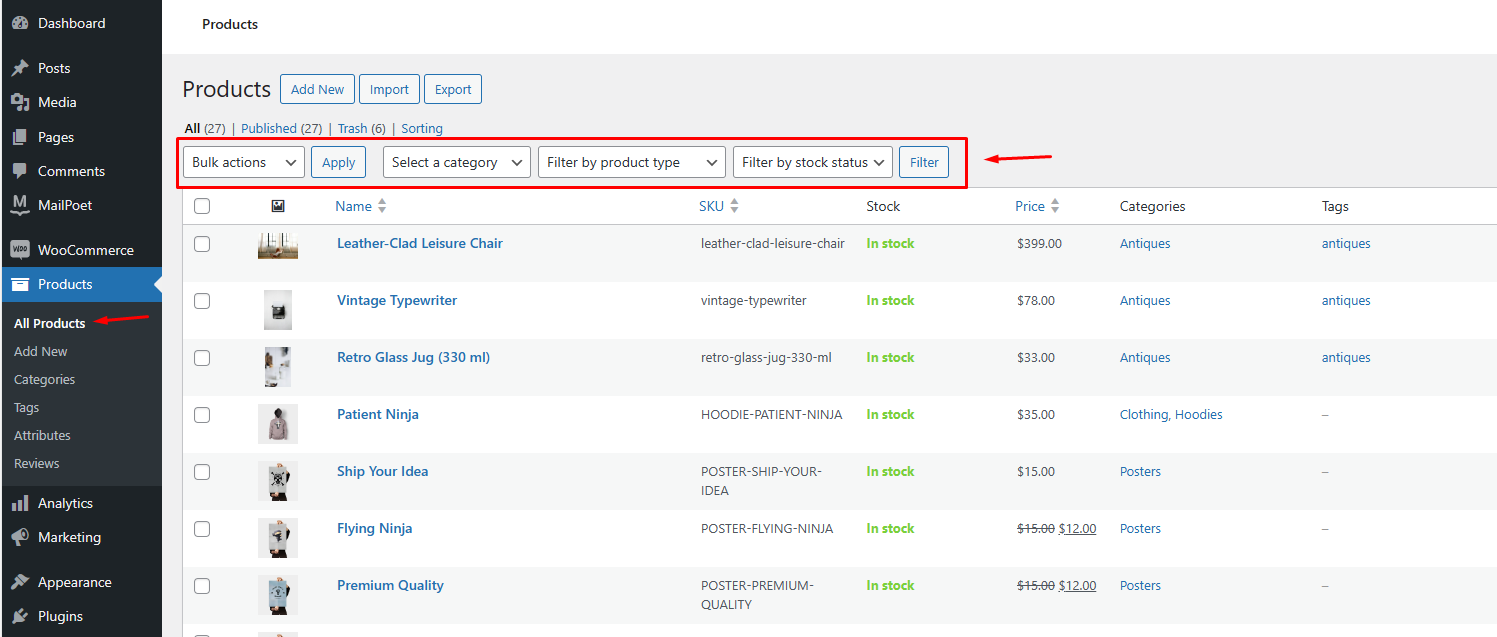
Select the desired products and click on Quick Edit.
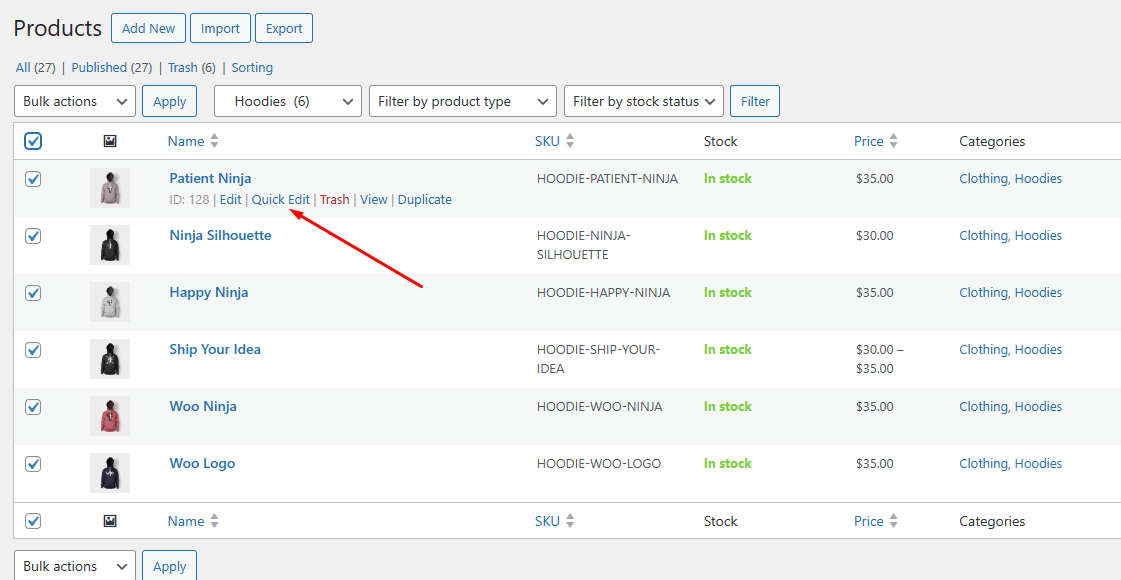
From the Quick Edit window, assign the appropriate class.
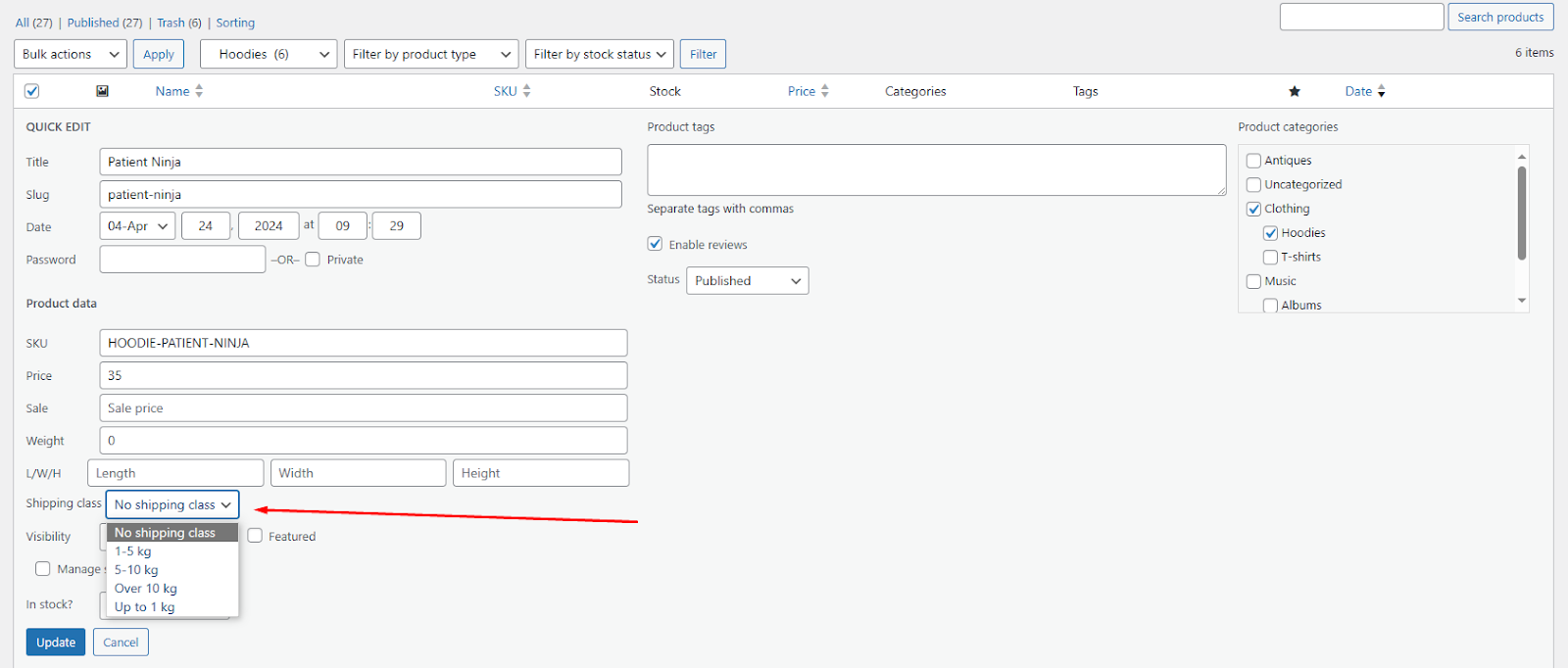
We haven’t set the rates yet, right? Let’s say this rate is for local customers.
Go to the Local shipping zone and click to edit the flat rate.
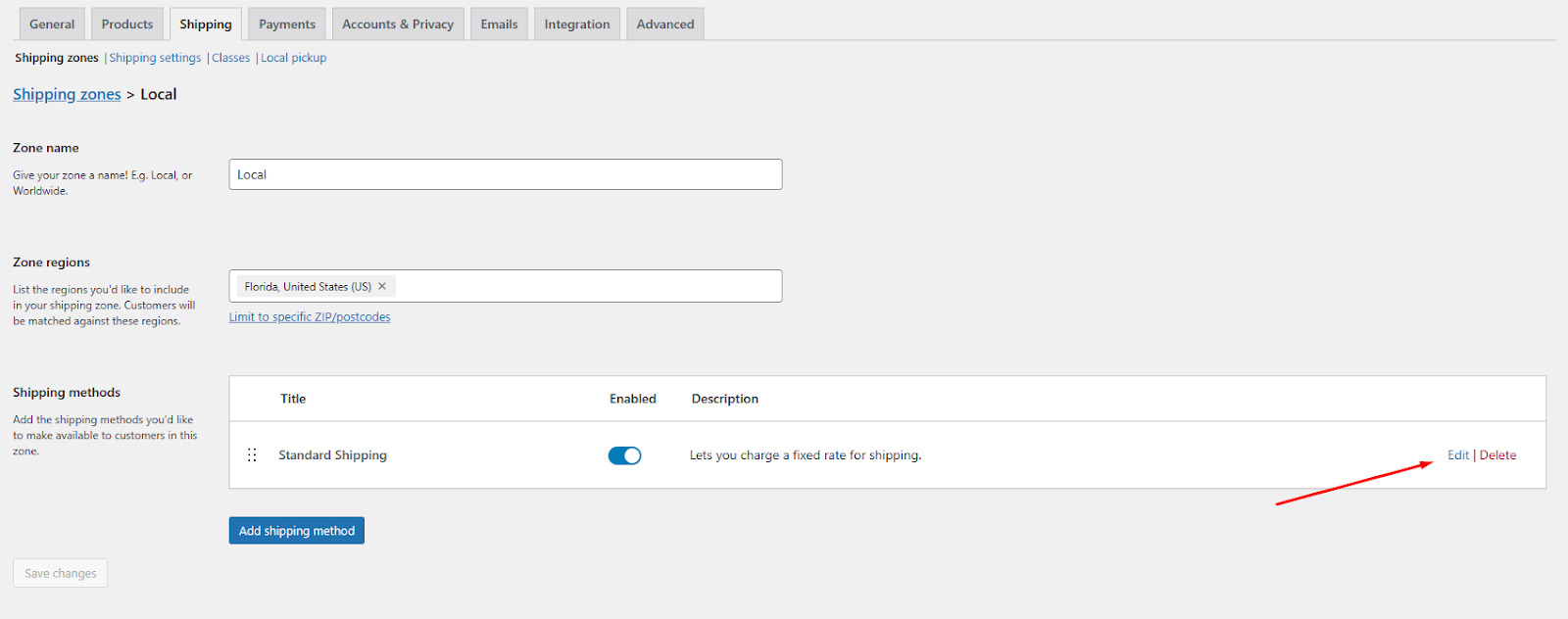
WooCommerce adds individual fields for all the classes you create. The rate you input here will be added to the primary cost field you set above.
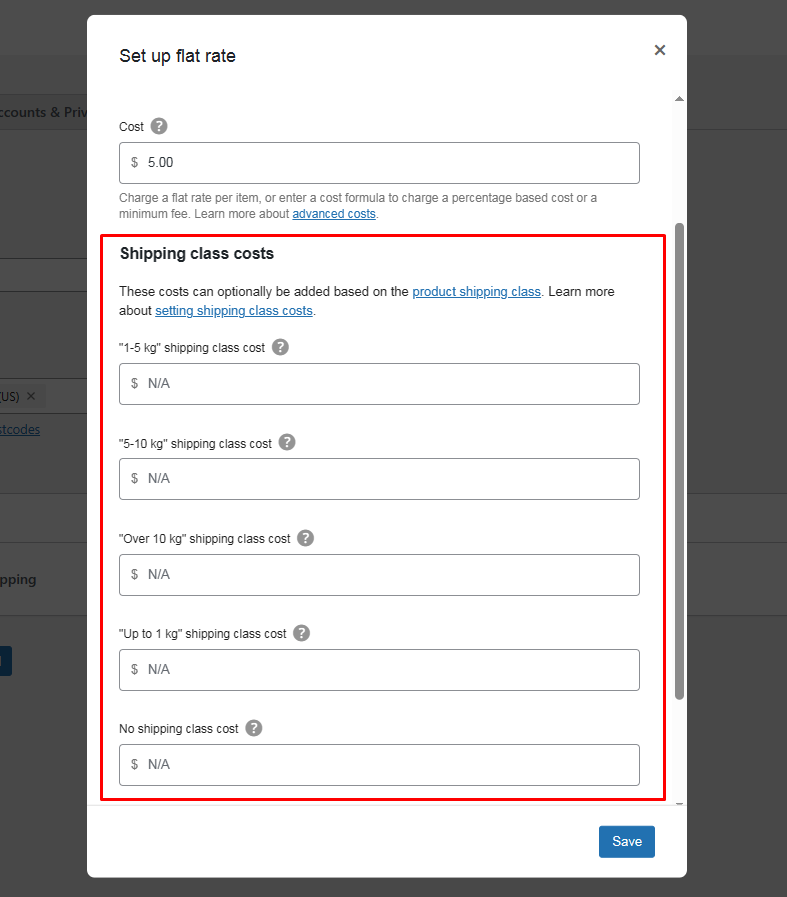
Set minimum table rate shipping cost WooCommerce in the primary cost field as you did before.
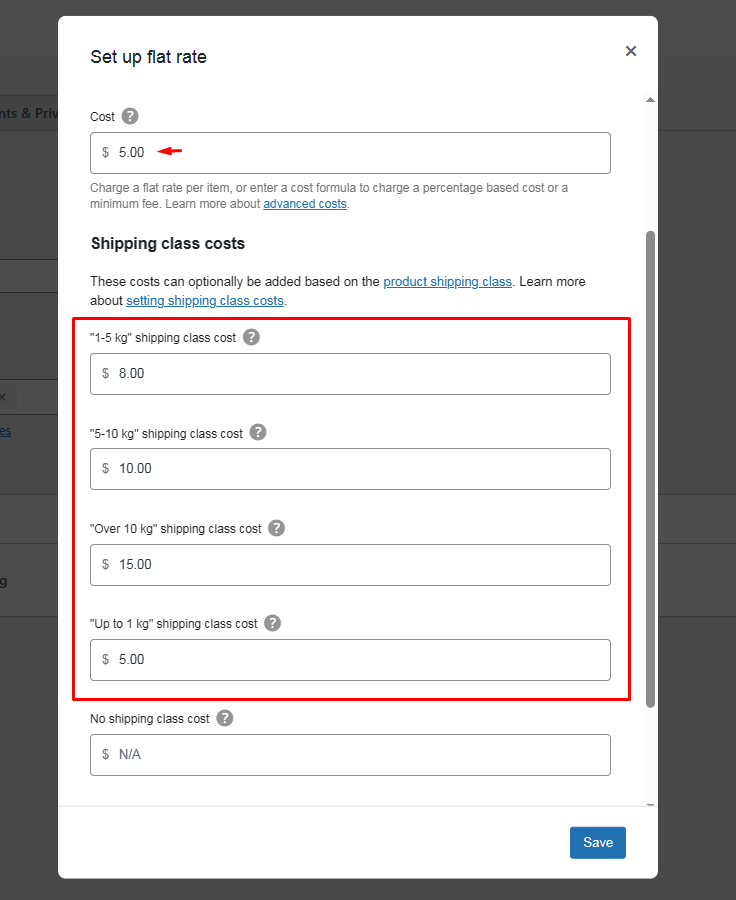
Let’s save them and check from the front.
We have added a product with a below 1 kg weight. Therefore, the shipping calculator sets the price – $5 (Primary cost) + $5 (Up to 1 kg class cost) = $10.
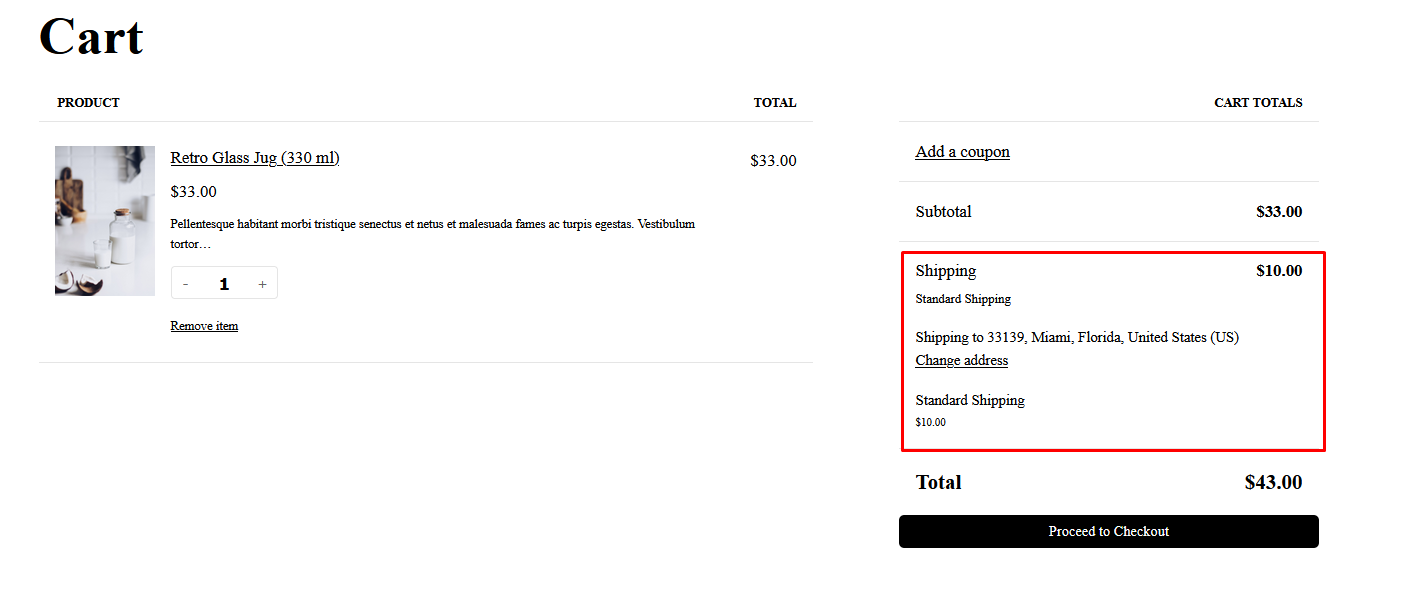
Let’s add an over 10 kg product.
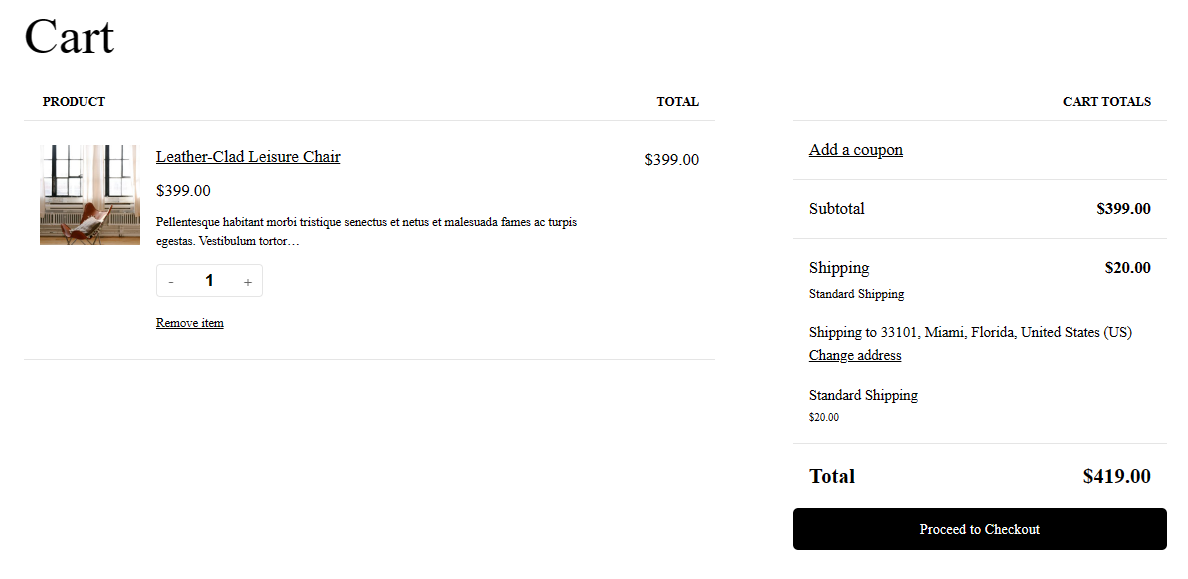
Primary cost $5 + Over 10 kg cost $15 = $20, as you can see in the example above. Let’s add another product between 1-5 kg along with the current added ones.
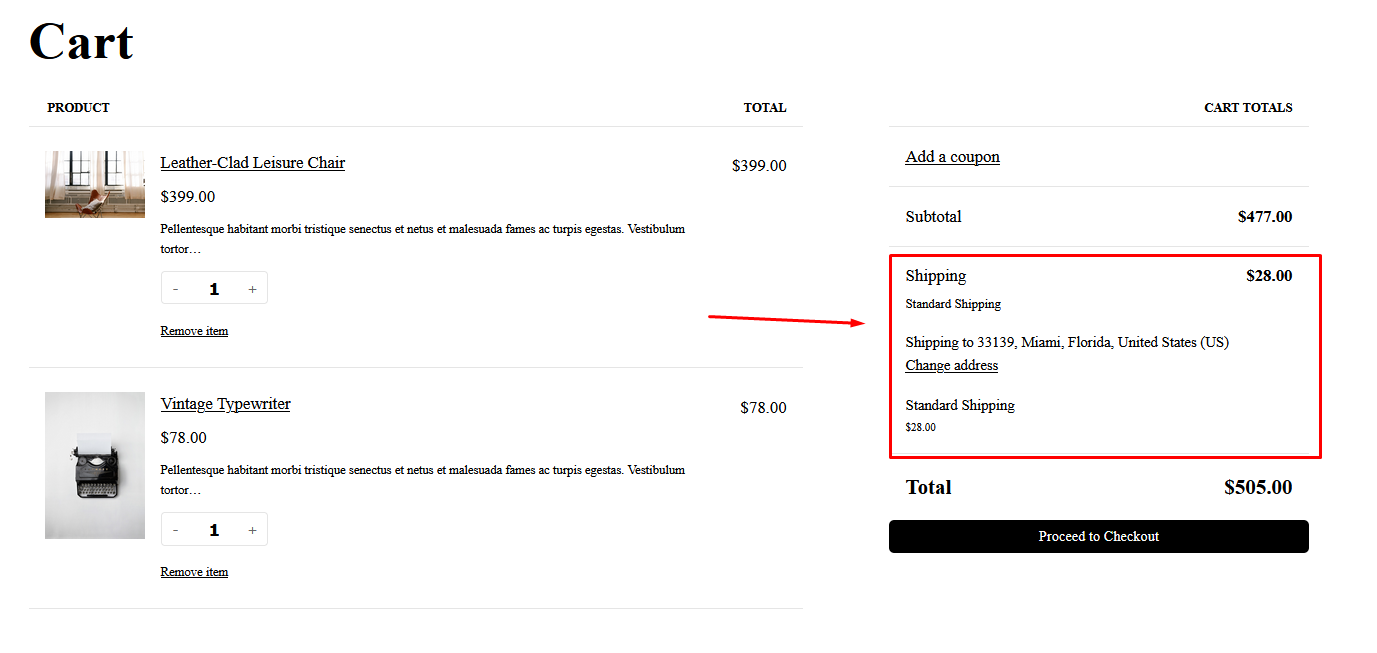
Primary cost $5 + Over 10 kg cost $15 + 1-5 kg cost $8 = Total $28.
Replicating WooCommerce Table Rate Shipping Example 4
The example was –
Combination of Weight and Destination:
Within Zone 1 (Local):
- Up to 1 kg: $5.00
- 1-5 kg: $8.00
- 5-10 kg: $10.00
- Over 10 kg: $15.00
Zone 2 (Regional):
- Up to 1 kg: $8.00
- 1-5 kg: $12.00
- 5-10 kg: $15.00
- Over 10 kg: $20.00
Within Zone 3 (National):
- Up to 1 kg: $10.00
- 1-5 kg: $15.00
- 5-10 kg: $20.00
- Over 10 kg: $25.00
We have already done this, haven’t we? We did it for the local zone.
You have already created the classes needed and assigned them to the appropriate products. All you need to do is go to other zones and edit the flat-rate shipping method costs.
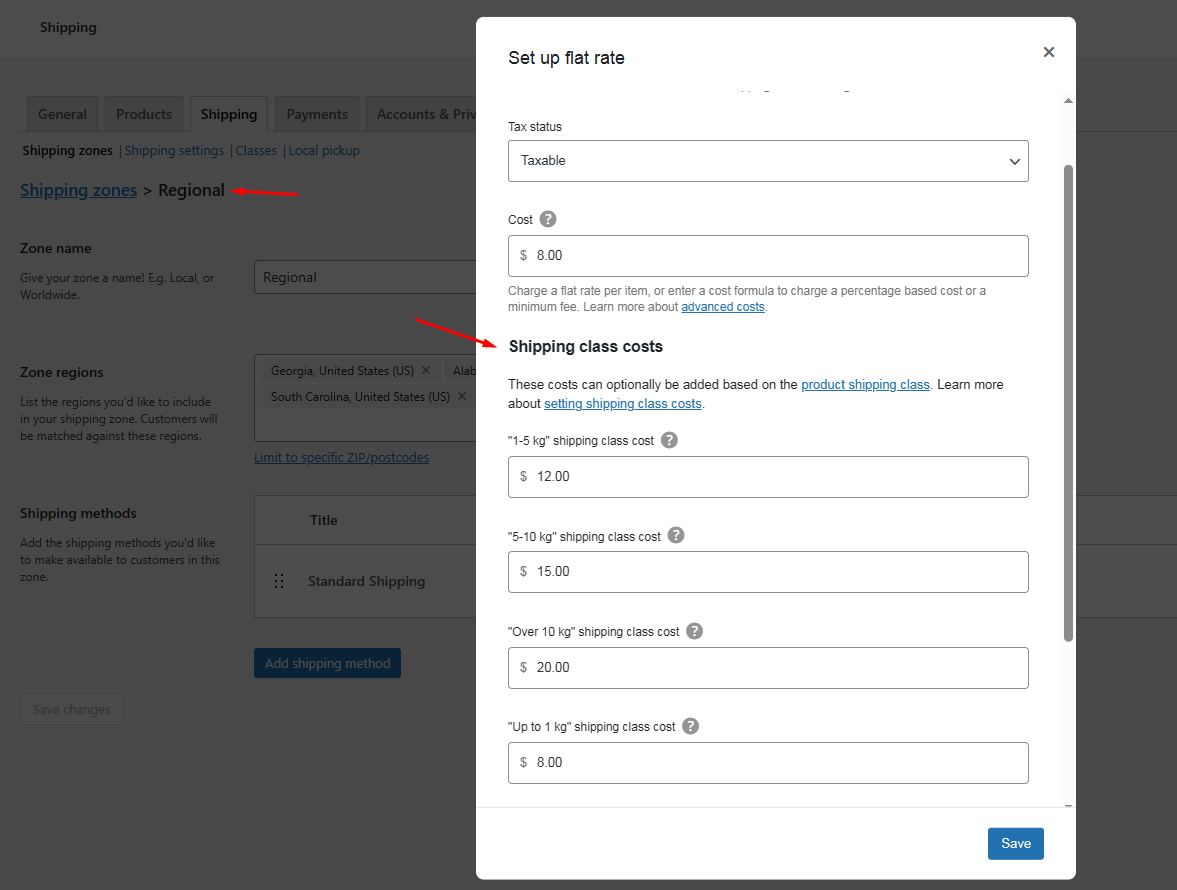
Let’s change the location of our previous example cart.
Here’s what it shows now.
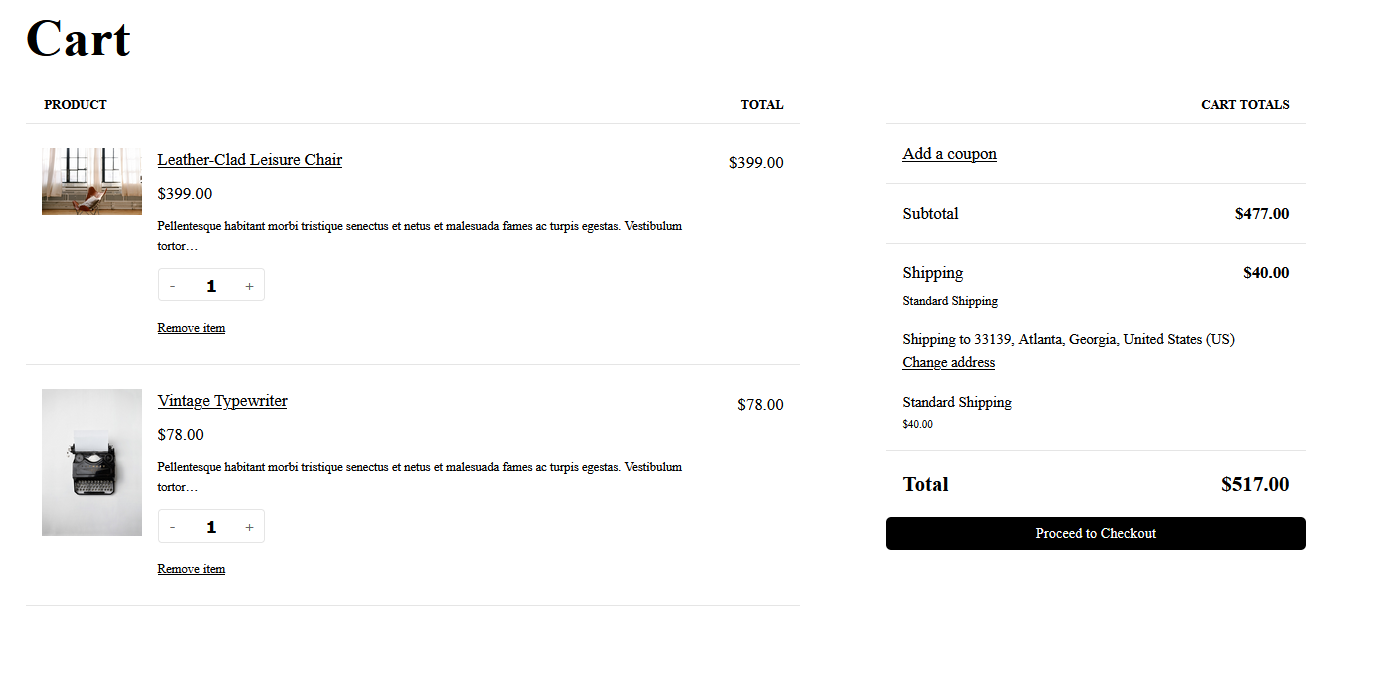
Primary cost $8 + Over 10 kg cost $20 + 1-5 kg cost $12 = Total $40.
Replicating WooCommerce Table Rate Shipping Examples 3 and 5
The examples were –
Quantity-based Rates:
- 1 item: $5.00
- 2 items: $8.00
- 3-5 items: $10.00
- 6-10 items: $15.00
Tiered Rates based on Order Value:
- Up to $50: $5.00
- $50 – $100: $8.00
- $100 – $200: $10.00
- Over $200: Free shipping
Unfortunately, you cannot achieve both quantity-based rates and tiered rates based solely on order value using only the default WooCommerce shipping settings.
Here’s why:
Quantity-Based Rates: Flat rate shipping calculations in WooCommerce don’t directly consider the exact number of items in the cart (represented by [qty]). They work with fixed costs, order weight, or percentages of the order total.
Tiered Order Value Rates: While you can create multiple flat rate methods with different costs, there’s no built-in way to define conditions based on specific order value ranges.
Overall, you can find workarounds for achieving WooCommerce table rate shipping using the built-in options to some extent. We have tried to cover as much as we can above.
However, there’s a great margin of limitations, and you must put a lot of effort into it. The best solution is using a dedicated WooCommerce table rate shipping plugin.
WooCommerce Table Rate Shipping Using a Plugin
WooCommerce offers basic shipping options, but for stores with specific needs, table rate shipping plugins provide a powerful solution. These plugins let you define custom shipping rates based on various criteria, giving you more control over your shipping costs.
Benefits of Using Table Rate Shipping Plugins:
- Granular Control: Set up tiered shipping rates based on weight, cart total, item count, shipping class, or even destination (including wildcards for regions). This allows you to offer competitive rates for different order sizes or locations.
- Increased Flexibility: Create multiple shipping tables for different scenarios. You can have special rates for heavy items, discounts for bulk orders, or free shipping above a certain amount.
- Improved Customer Experience: Customers can see clear and relevant shipping costs at checkout, reducing surprises and boosting confidence in their purchase.
- Boost Revenue: Implement strategic rate structures to incentivize larger orders or offset higher shipping costs for specific products.
In essence, table rate shipping plugins empower you to create a win-win situation for both your store and your customers. With a variety of free and paid plugins available, you can find the perfect solution to meet your specific needs and budget.
Set Table Rate Shipping Using a Plugin
We will demonstrate conditional shipping with the most popular WooCommerce table rate shipping plugin in the WordPress repository.
It’s called Table Rate Shipping Method for WooCommerce by Flexible Shipping. The plugin comes with easy-to-follow WooCommerce table rate shipping documentation.
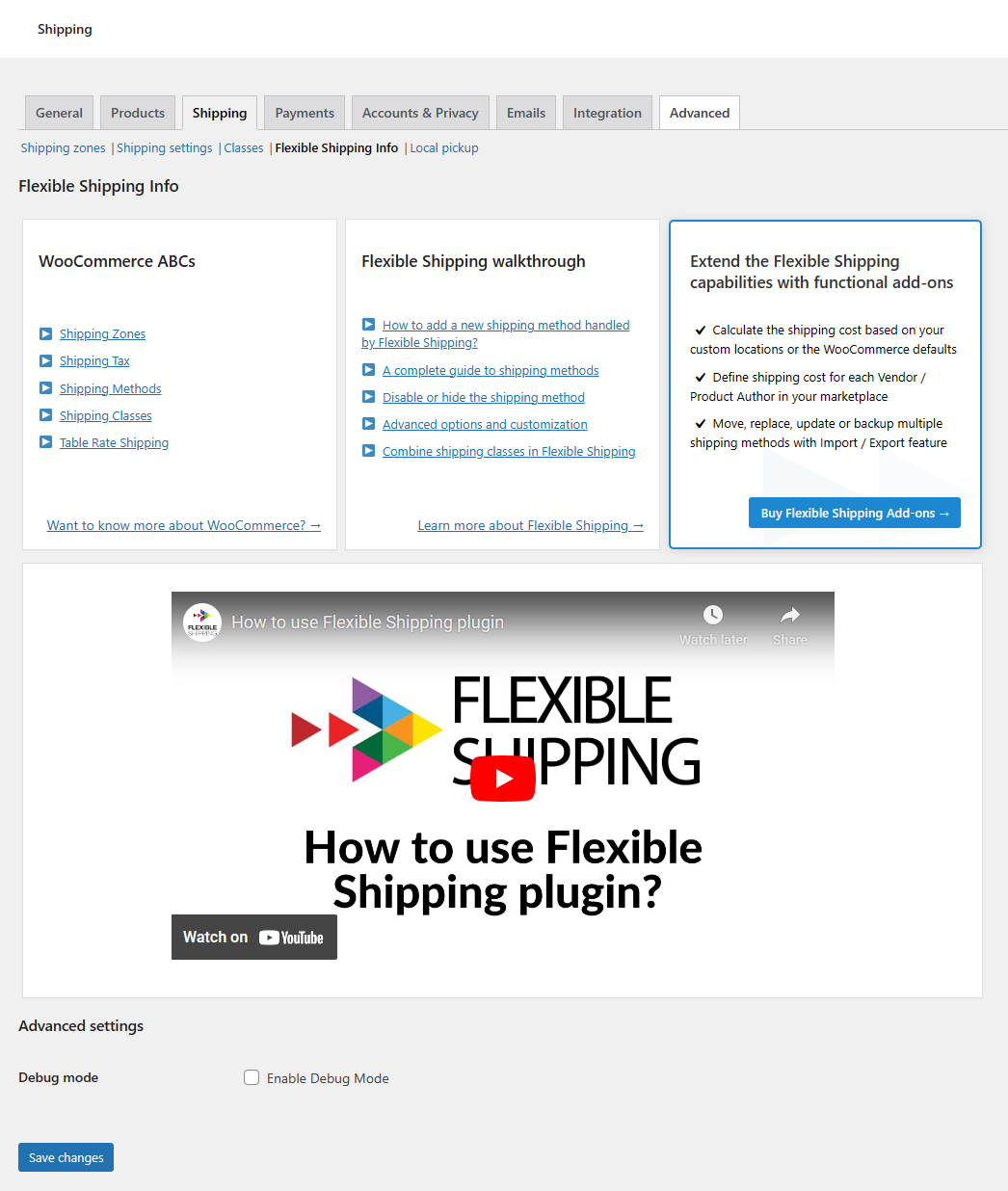
It also facilitates WooCommerce table rate shipping tutorial videos so you can learn and implement different shipping conditions with ease. The plugin also has a premium version that offers a wide range of additional shipping conditions.
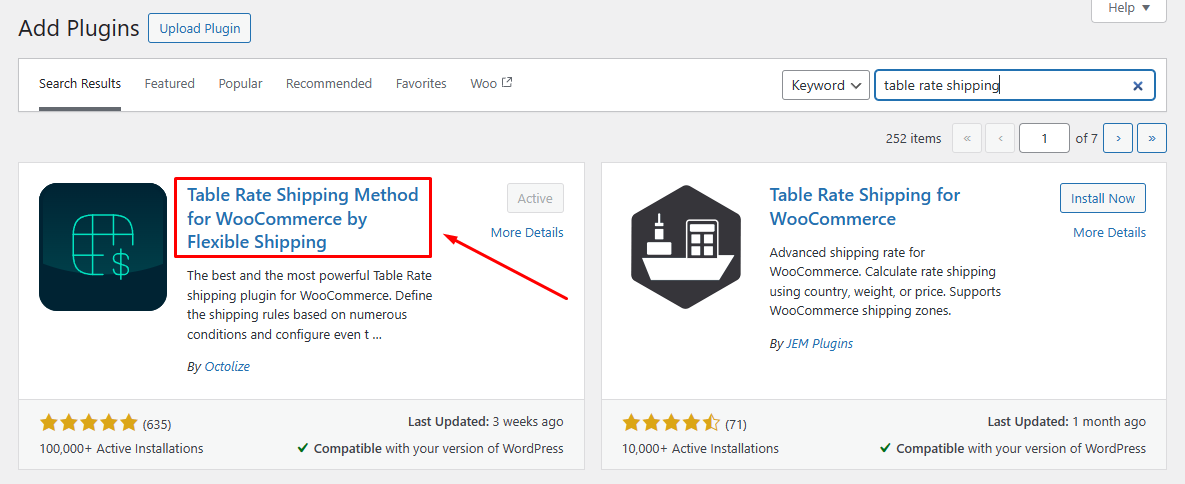
For this article, we will use the pro version. After you install the plugin, go back to WooCommerce Shopping settings.
Edit any of your existing shipping zones or create a new one.
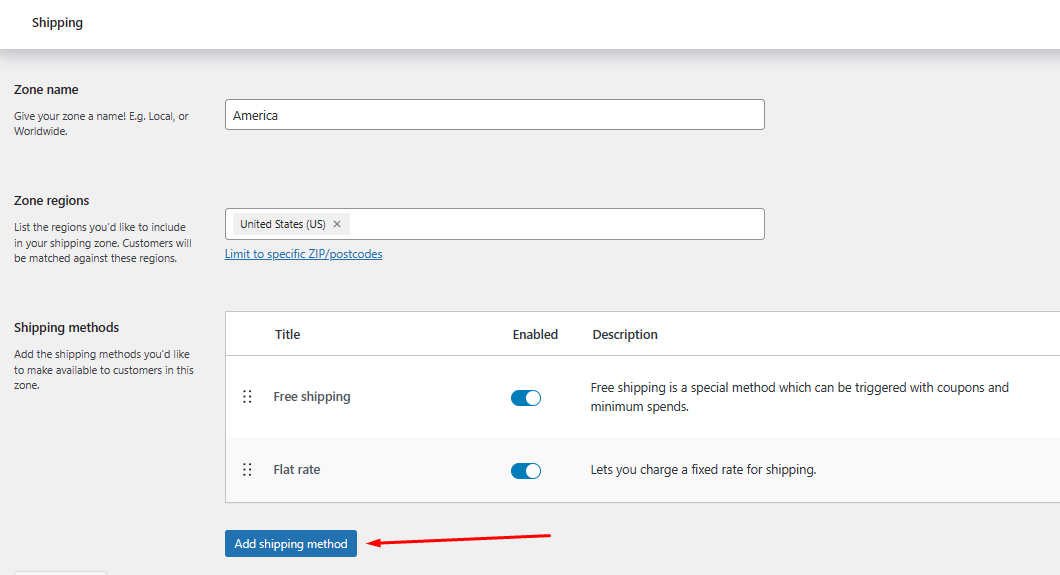
Click to add a new shipping method.
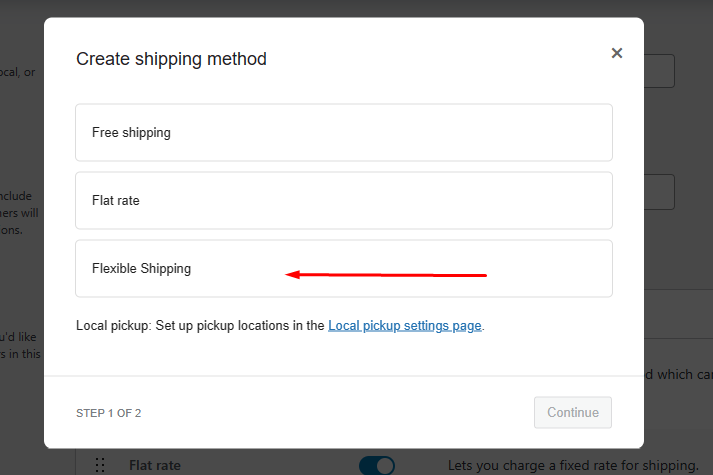
You will see a new option called – Flexible Shipping. Select and continue.
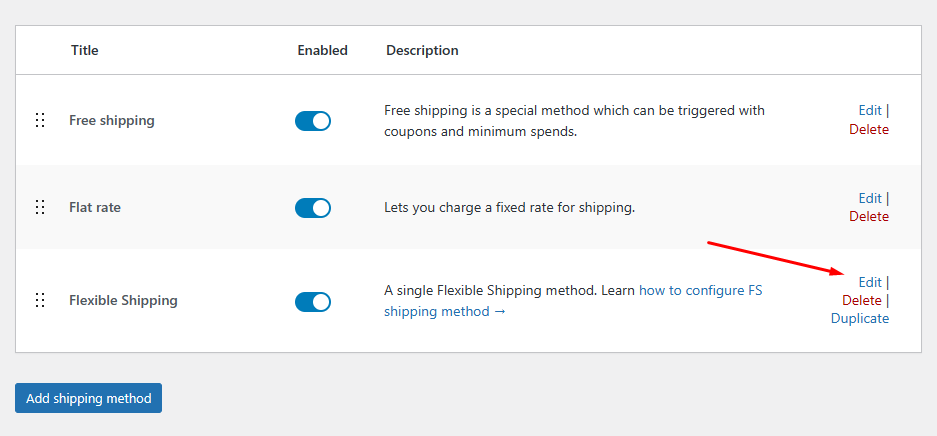
Click on Edit. It will take you to this new window.
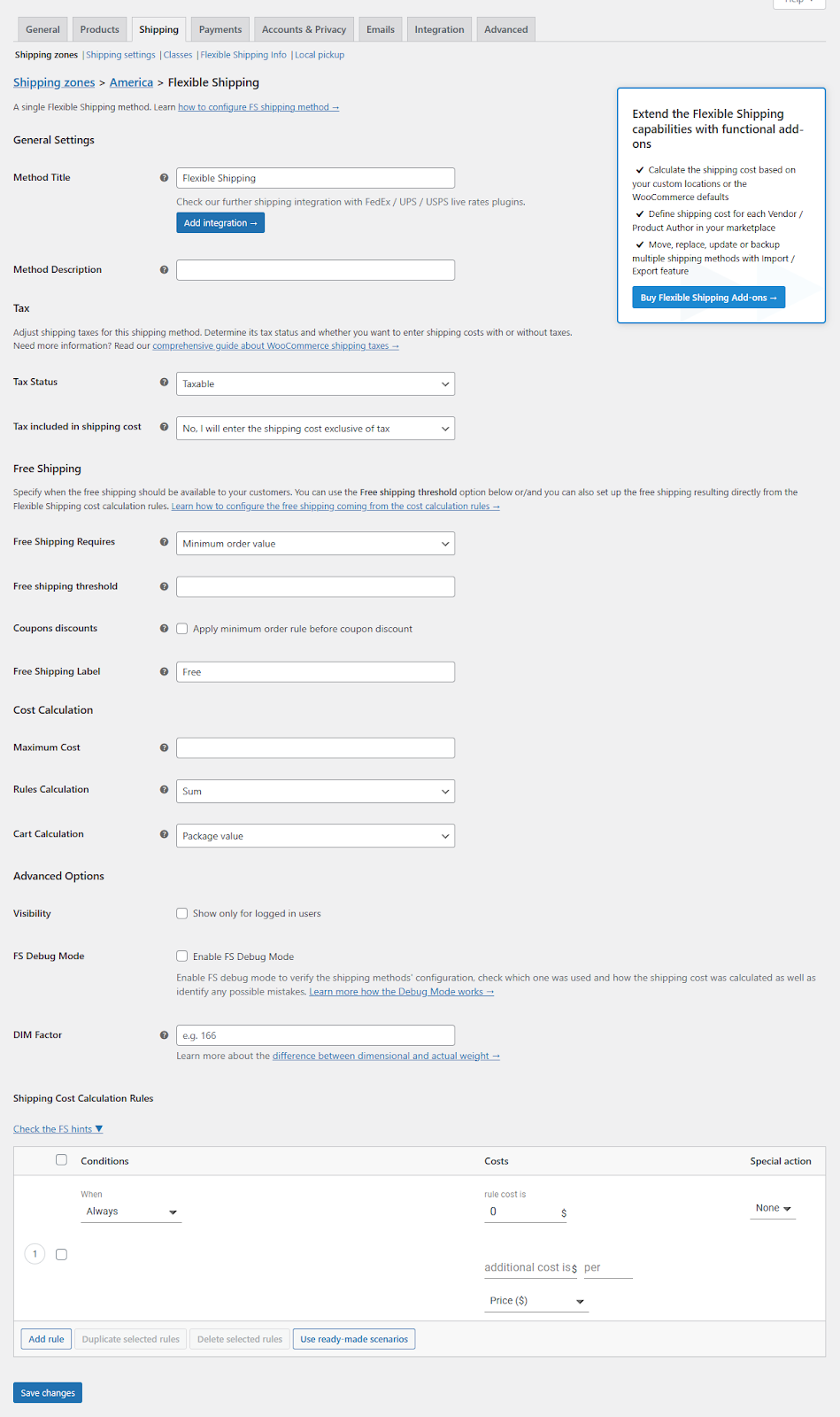
We will not explain all the details. You can learn about them from the documents page. Jump to the Shipping Cost Calculation Rules section.
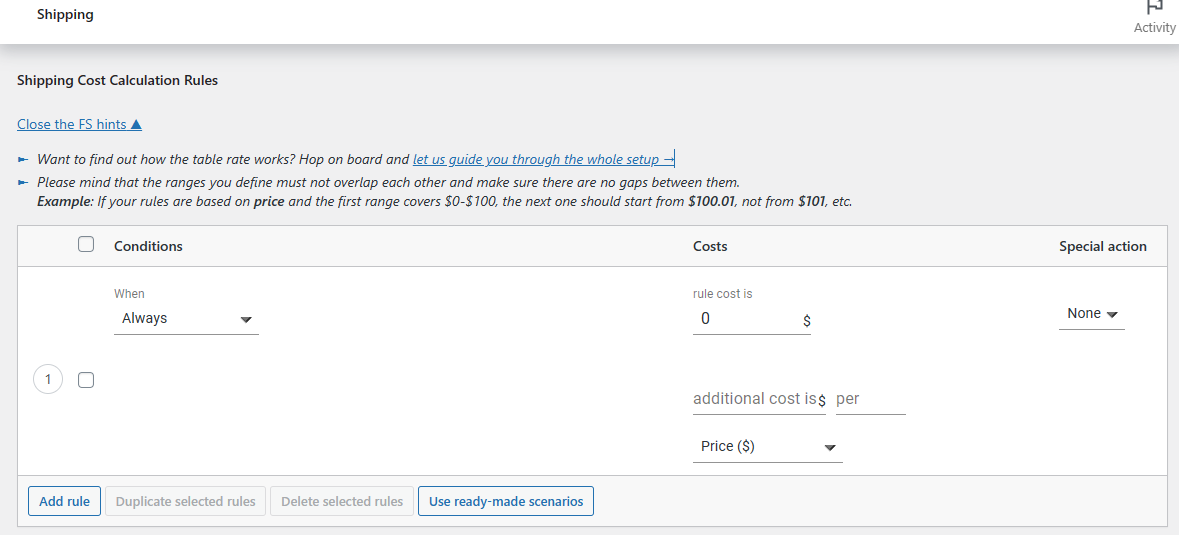
Now, let’s try and achieve examples 3 and 5. We will start with quantity-based rates.
Quantity-based Rates:
- 1 item: $5.00
- 2 items: $8.00
- 3-5 items: $10.00
- 6-10 items: $15.00
From the Condition dropdown, select Item.
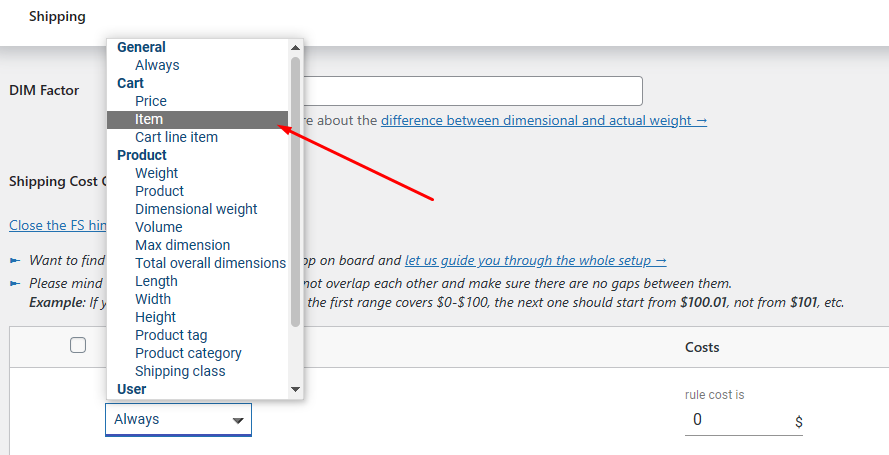
Set quantity numbers and rates.

Next, add another rule. Set your conditions and rates.
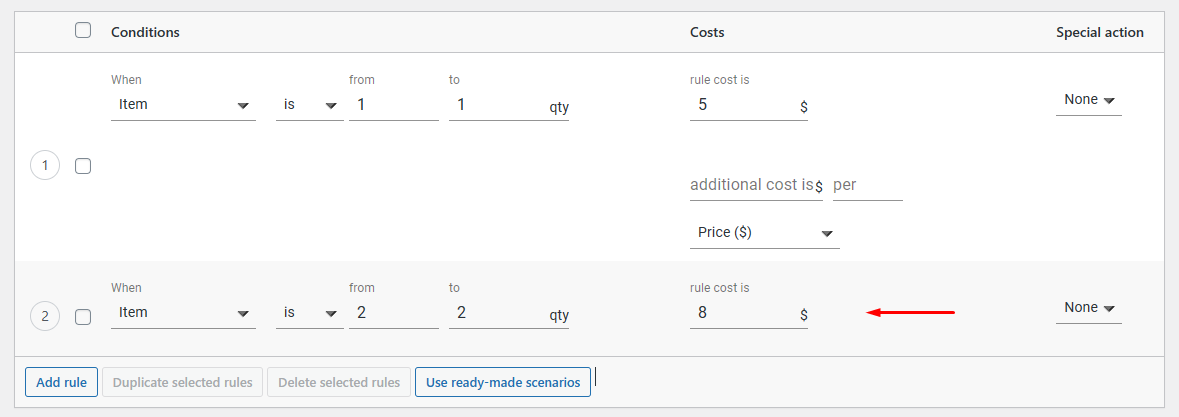
Similarly, add other rules and save your changes.
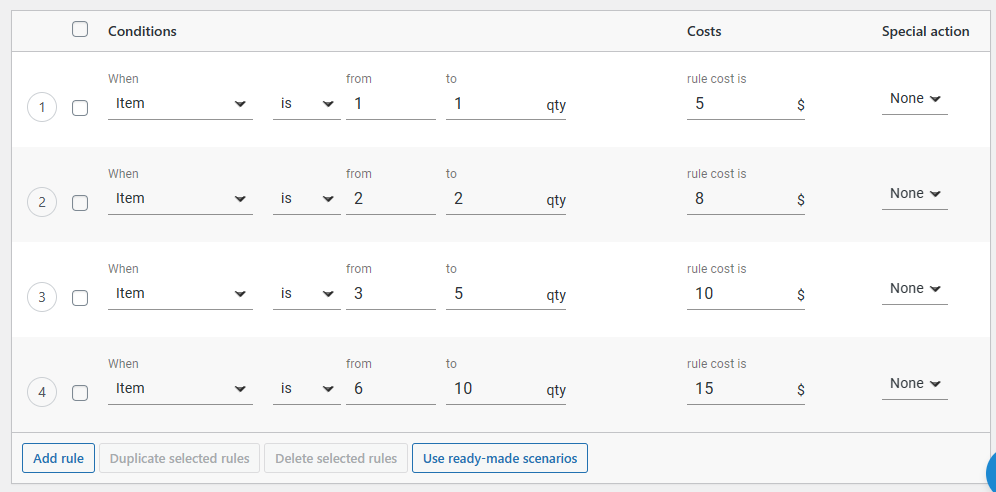
Now, let’s go to the front end and add one product.
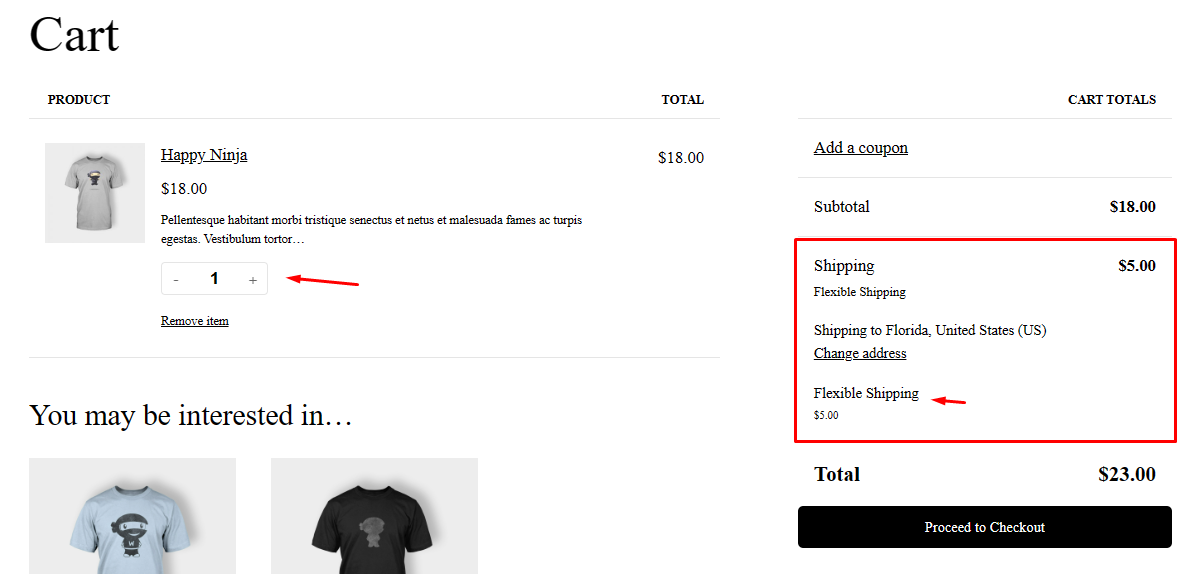
As you can see, WooCommerce displays the rate for one product as per your set condition. Let’s add some more.
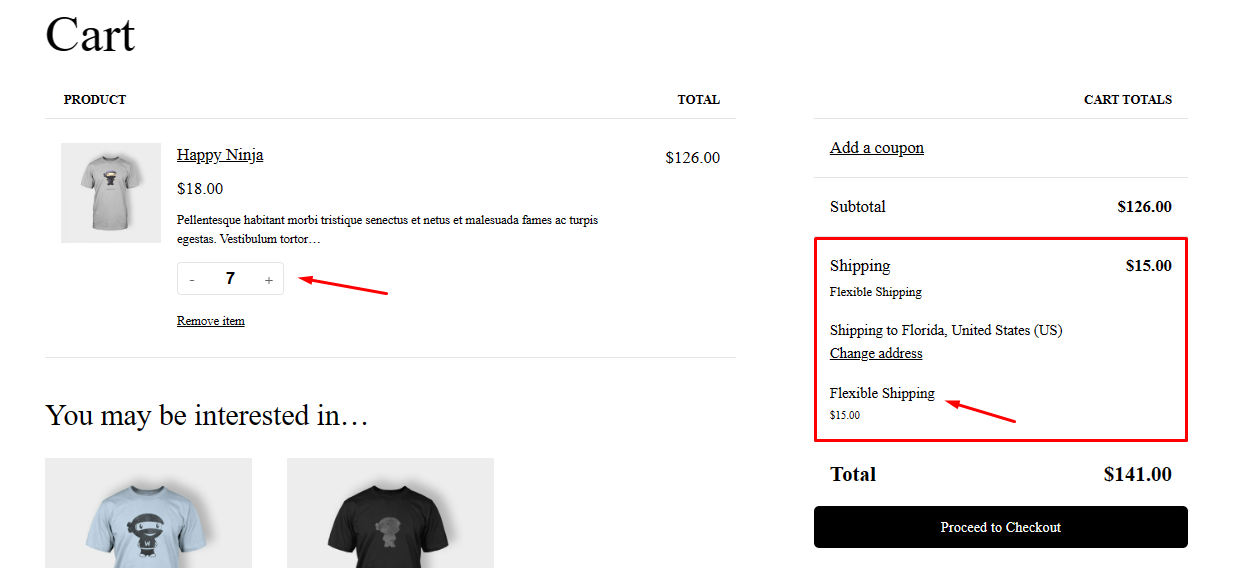
We have added 7 products that fall under the 6-10 items rule. That’s why the shipping cost is showing $15.
Setting Tiered-Based WooCommerce Table Rate Shipping Using a Plugin
Again, the example was –
Tiered Rates based on Order Value:
- Up to $50: $5.00
- $50 – $100: $8.00
- $100 – $200: $10.00
- Over $200: Free shipping
Again, edit or create a zone and add a Flexible Shipping method.
Jump to the Shipping Cost Calculation Rules section, and this time, add Price as a condition.
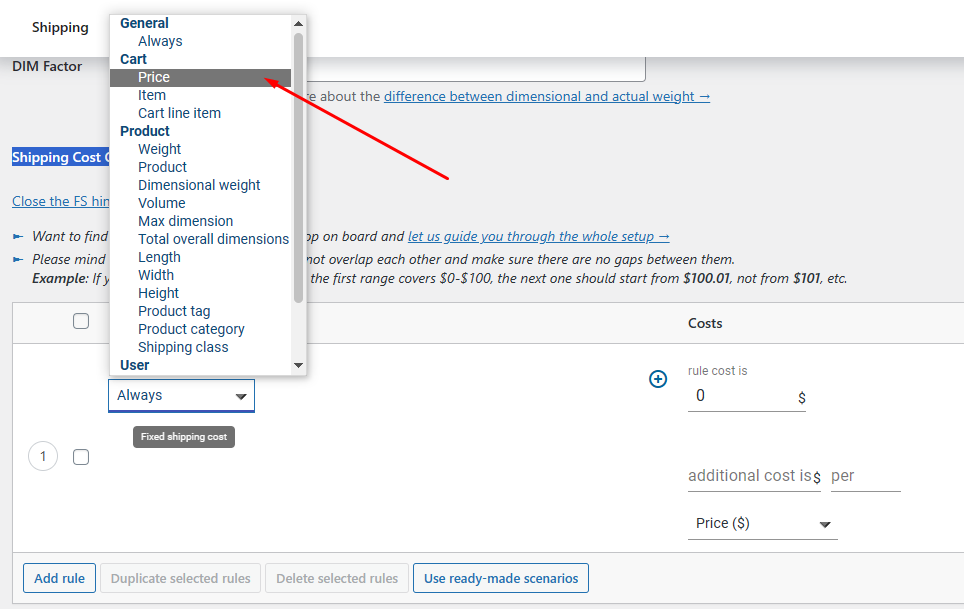
Set your conditions.
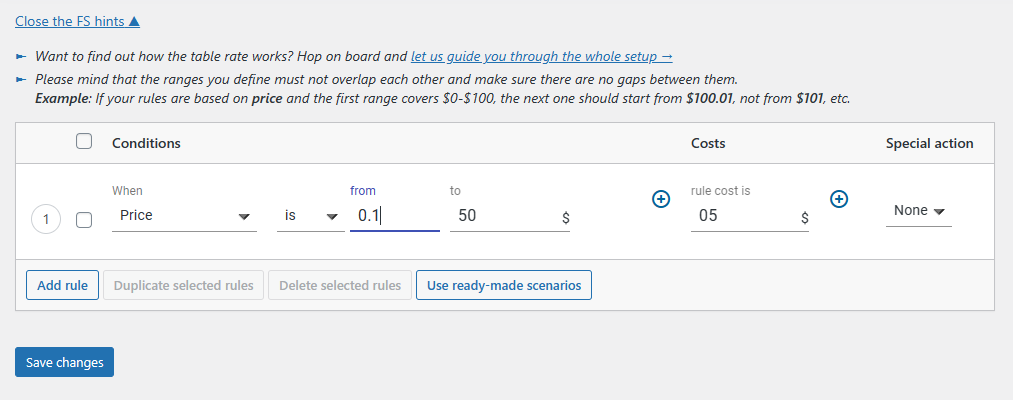
Similarly, add other rules and set conditions.
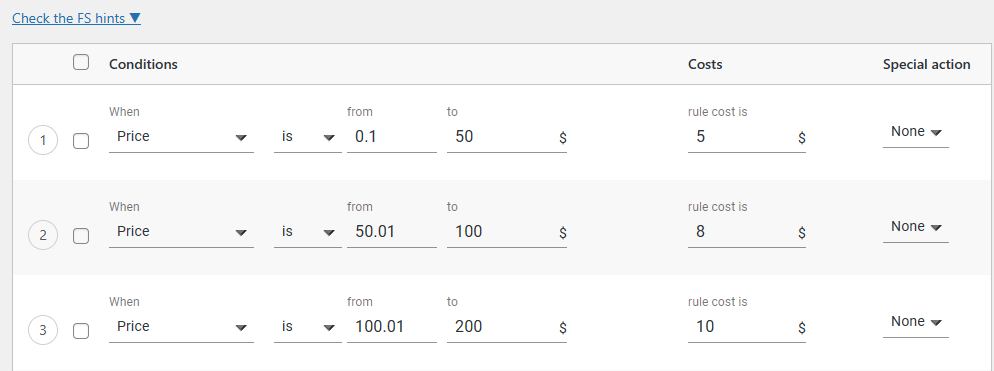
Now, as per example, we need to set free shipping when the order value is over $200. When using this plugin, you don’t need to create a separate shipping method for free shipping.
Simply scroll up the same page, and you will find the Free Shipping section there.

You can set free shipping by different conditions as well.
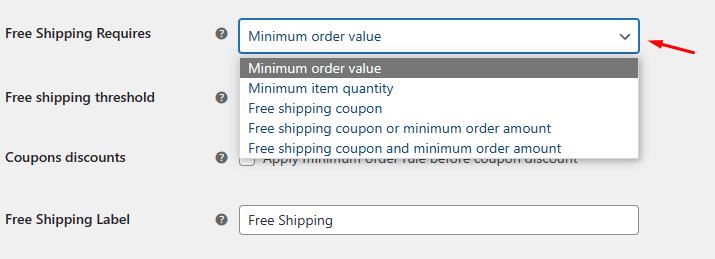
For our example, we will need the Minimum Order Value option.
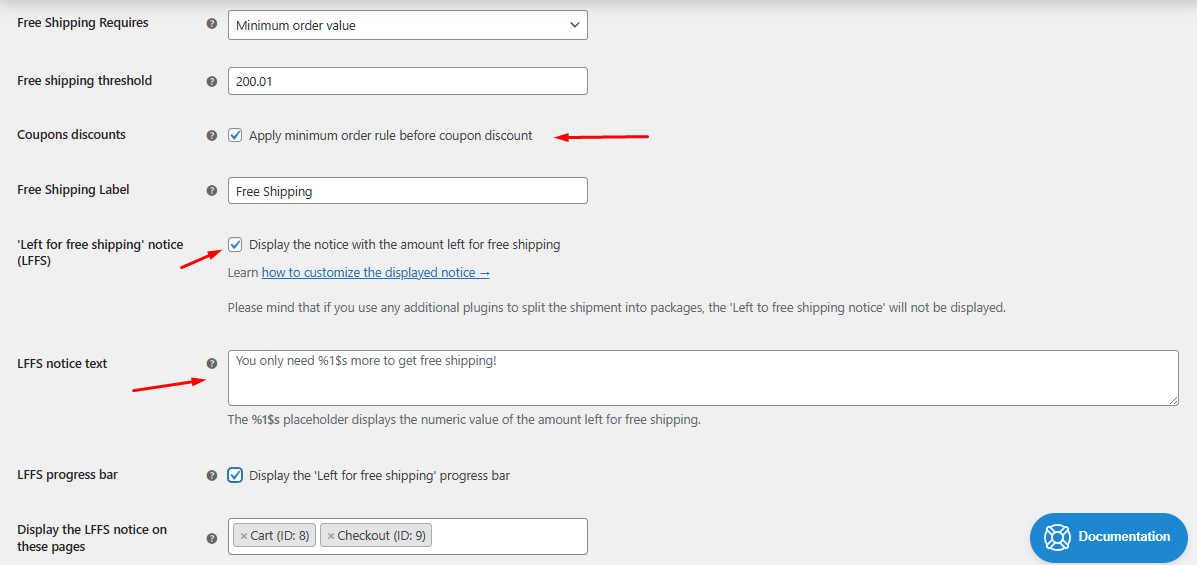
Coupons discounts—Apply minimum order rule before coupon discount: This means that even if a discount code reduces your customer’s total order value below the free shipping threshold, they will still enjoy free shipping based on the pre-discount order amount.
Left for free shipping’ notice (LFFS): When a customer adds some products to the cart, the plugin will display a message and a progress bar to notify them how much more they need to spend to qualify for free shipping.
Let’s save and check from the front end.
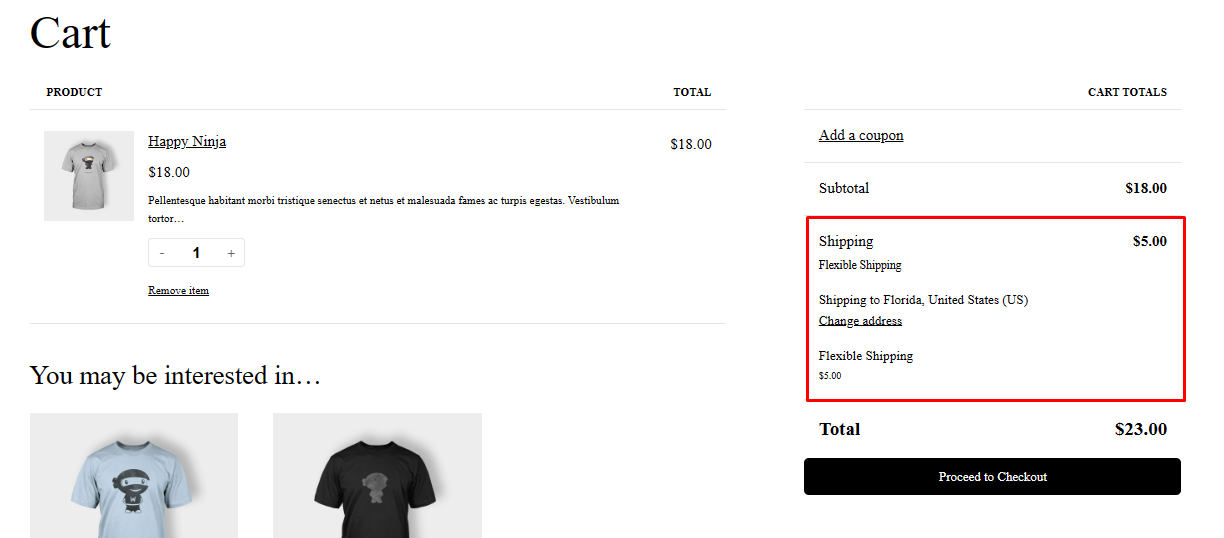
This is the below $50 shipping cost. Let’s check the rate for the $100 – $200 order value.
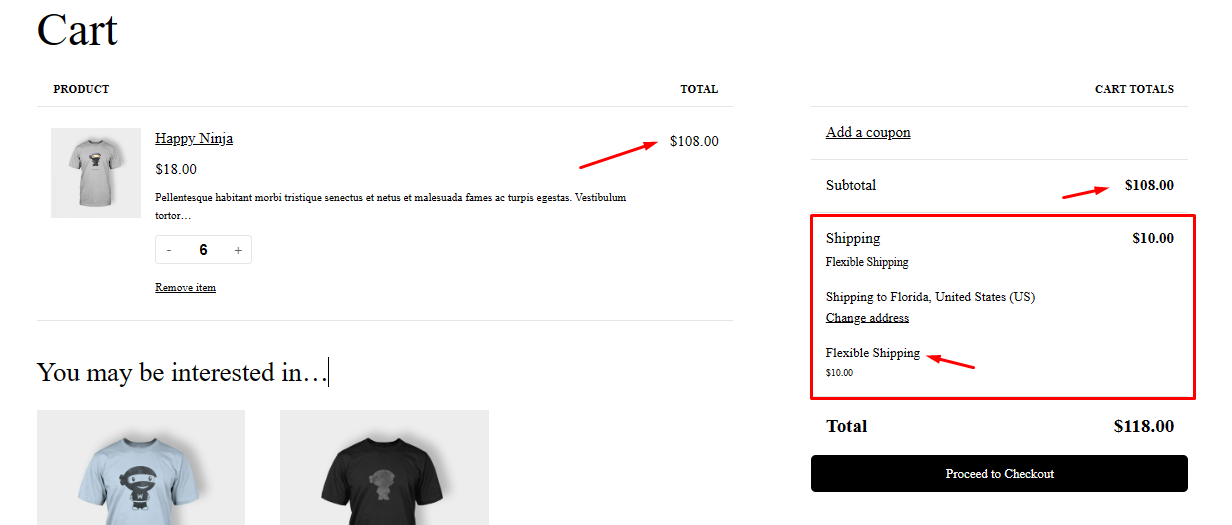
By the way, here’s how the plugin displays the LFFS notification and progress bar.

Let’s go over $200 to check if free shipping is working or not.
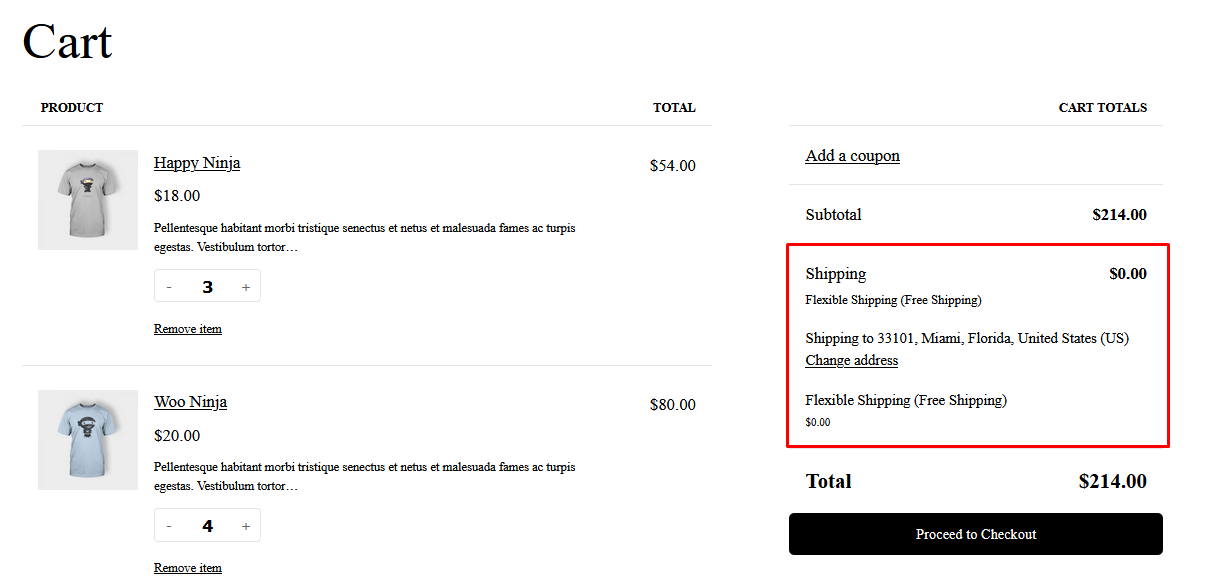
You can also apply free shipping conditions from the cost calculation rules as well.
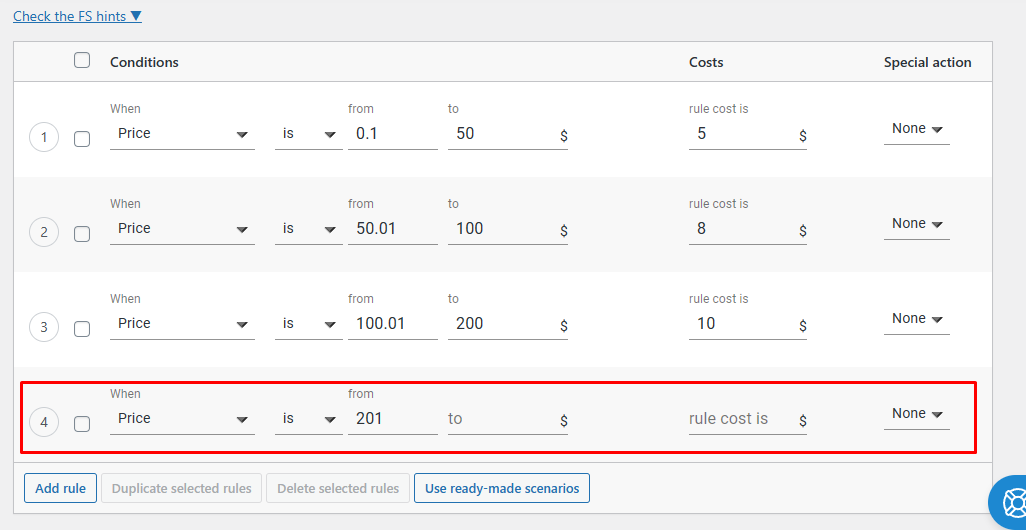
Overall, this plugin is your one-stop solution for all your shipping, especially WooCommerce table rate shipping requirements.
Wrap up
WooCommerce table rate shipping functionality offers a powerful and versatile solution for creating customized shipping rules in your online store. By leveraging factors like weight, price, location, and item count, you can establish a granular shipping structure that serves different customer requirements and product types.
Whether you’re looking to implement tiered shipping discounts, offer location-specific rates, or account for product weight variations, table rate shipping empowers you to create a strategic shipping strategy that improves customer satisfaction and potentially boosts your bottom line.
For even more advanced shipping conditions, consider exploring premium table rate shipping plugins, as we have shown above. These plugins provide a wide range of additional powerful features and flexibility.
We hope this article will help you set the appropriate shipping rules to cater to your customer’s needs.
